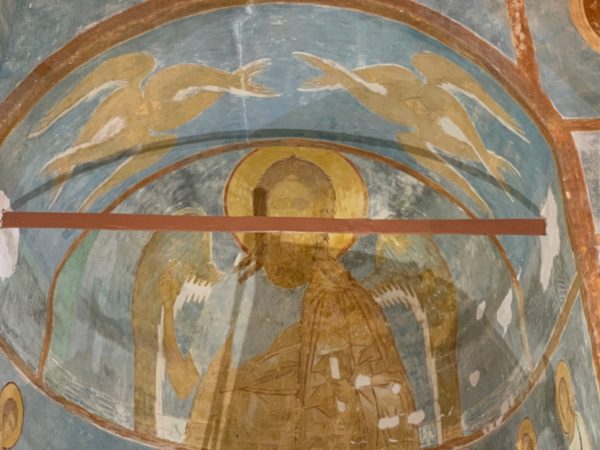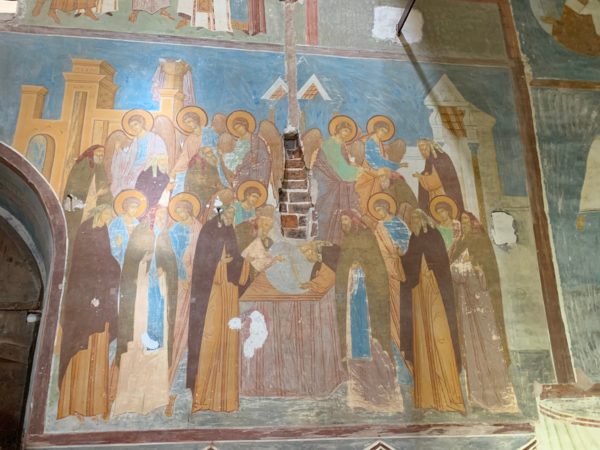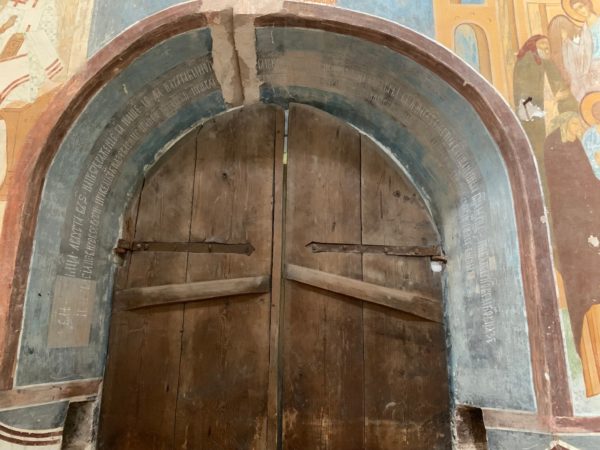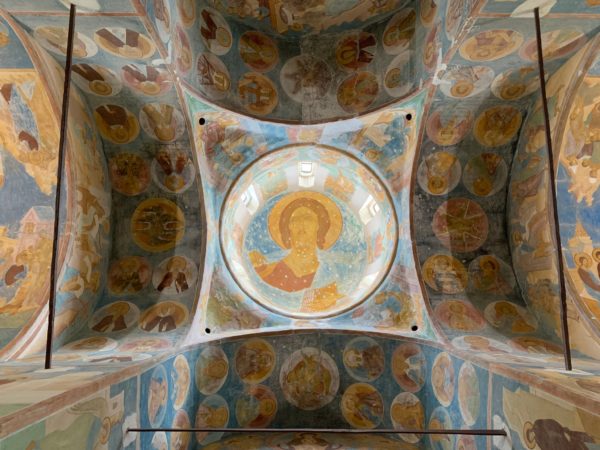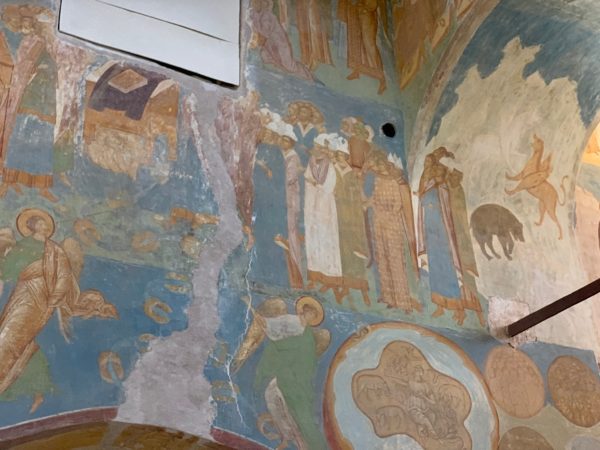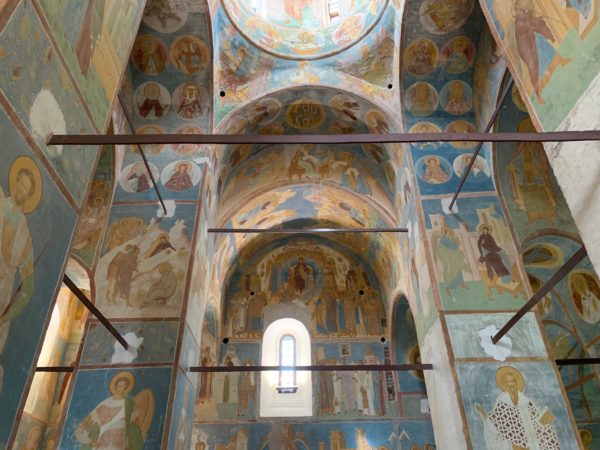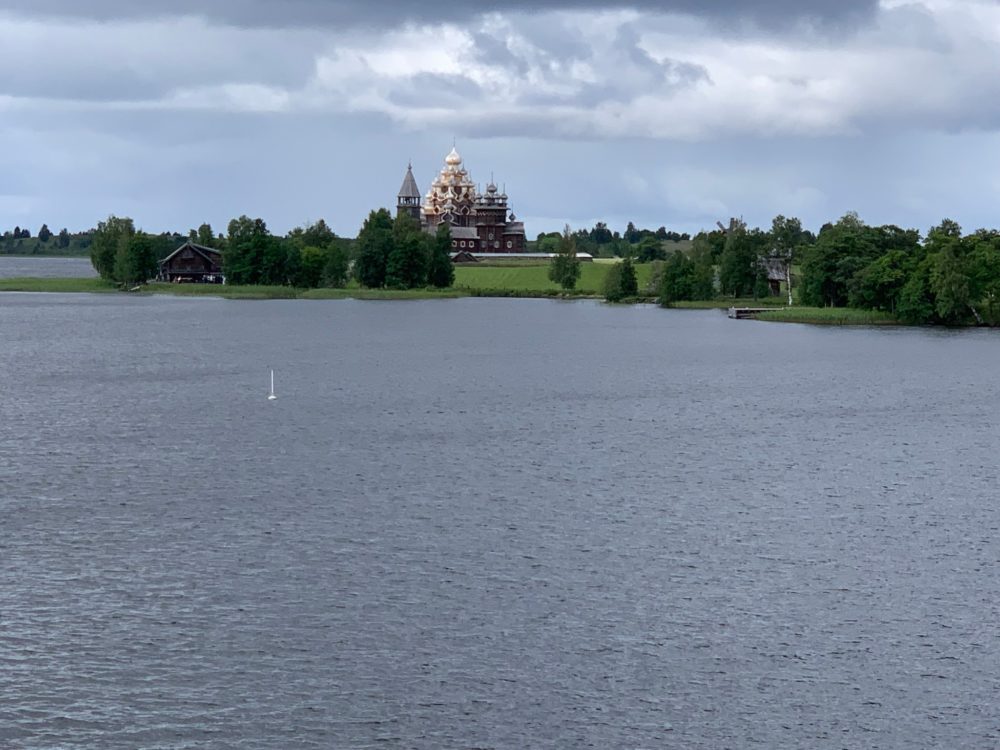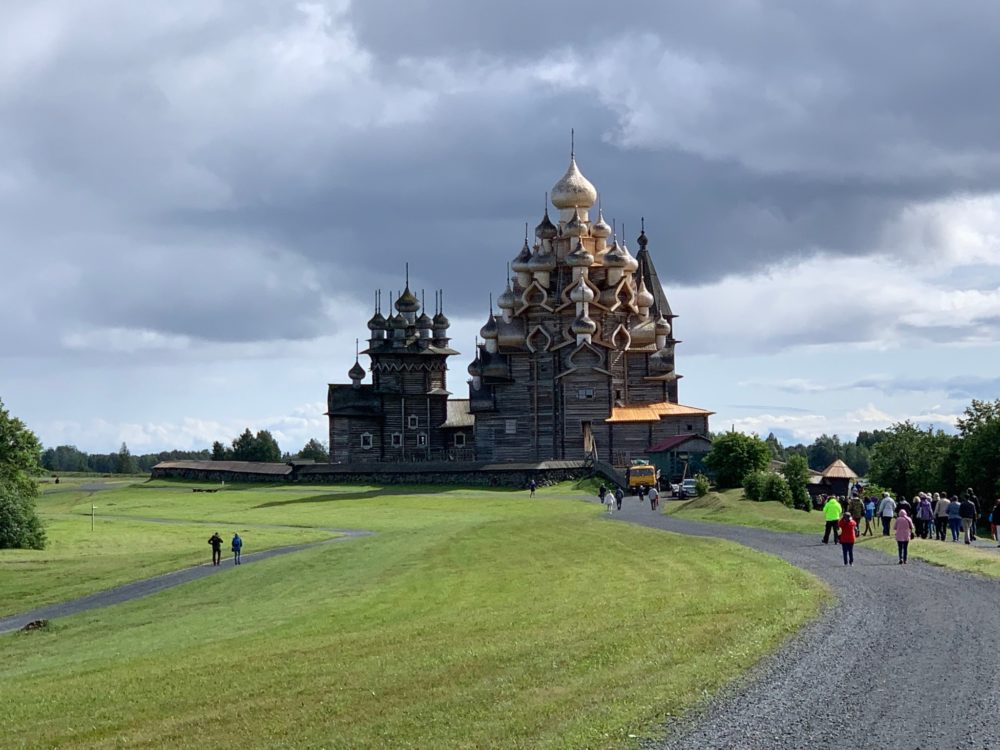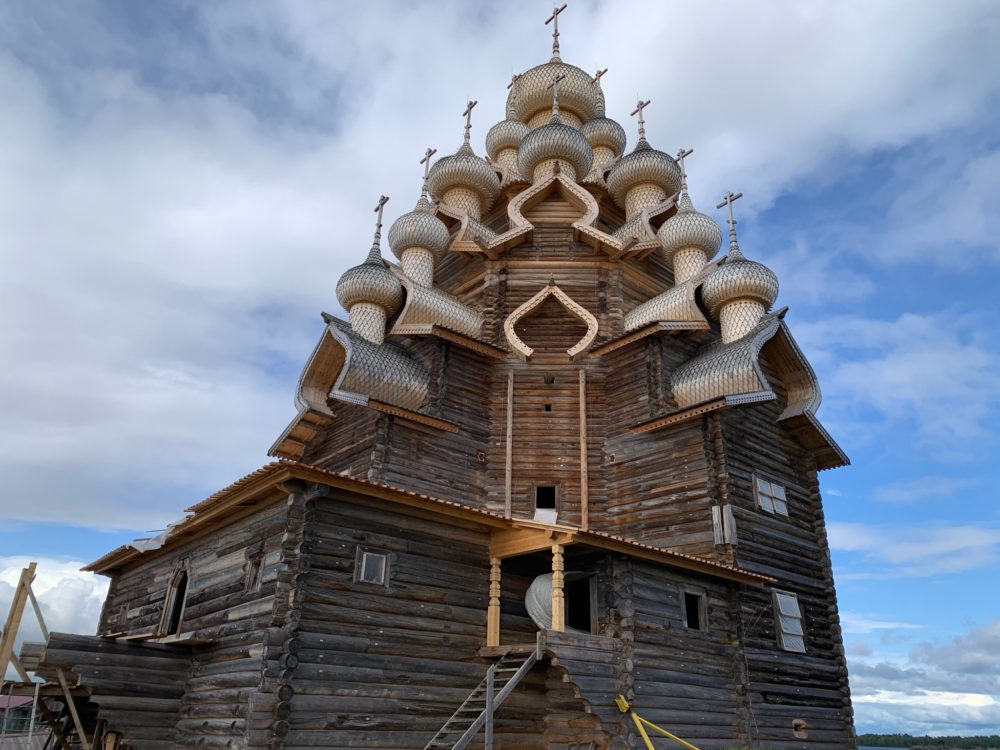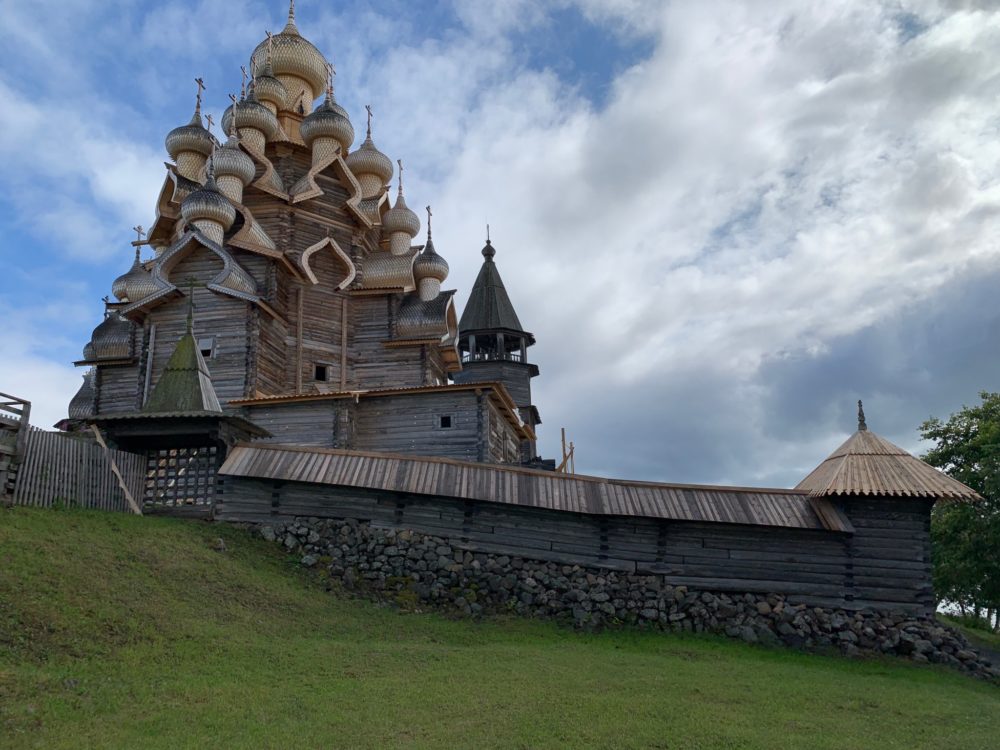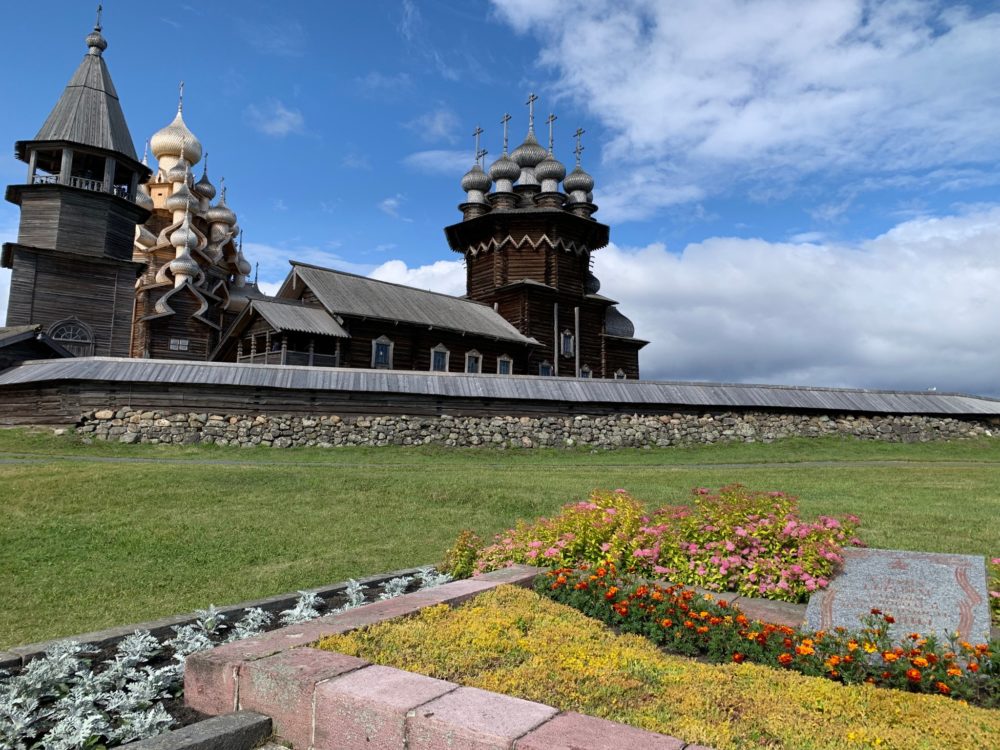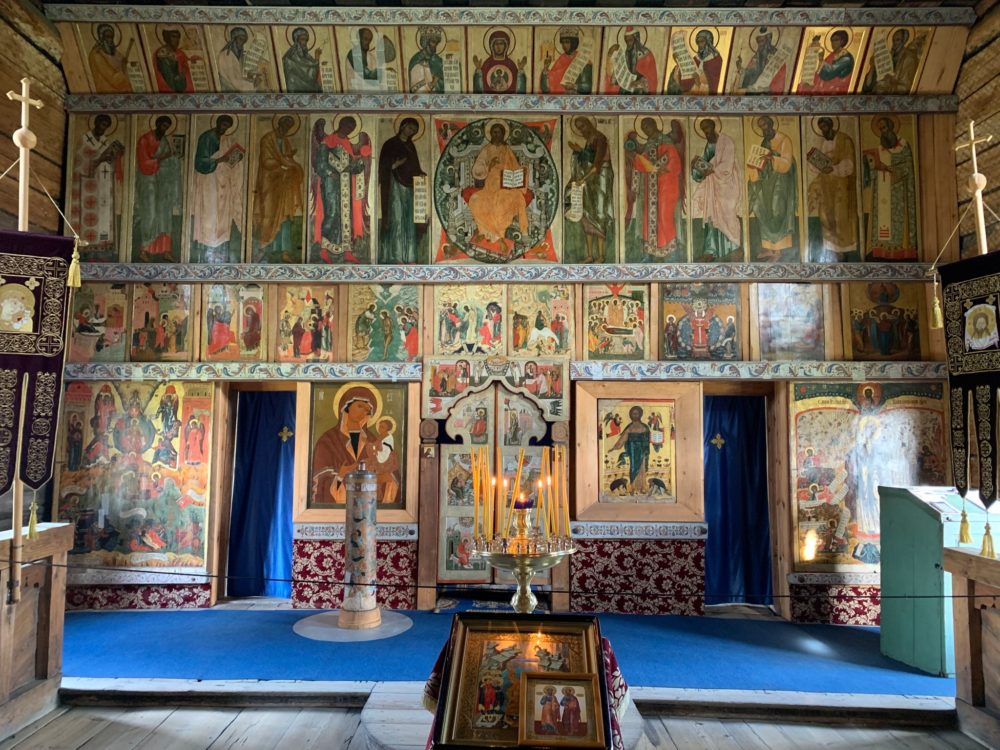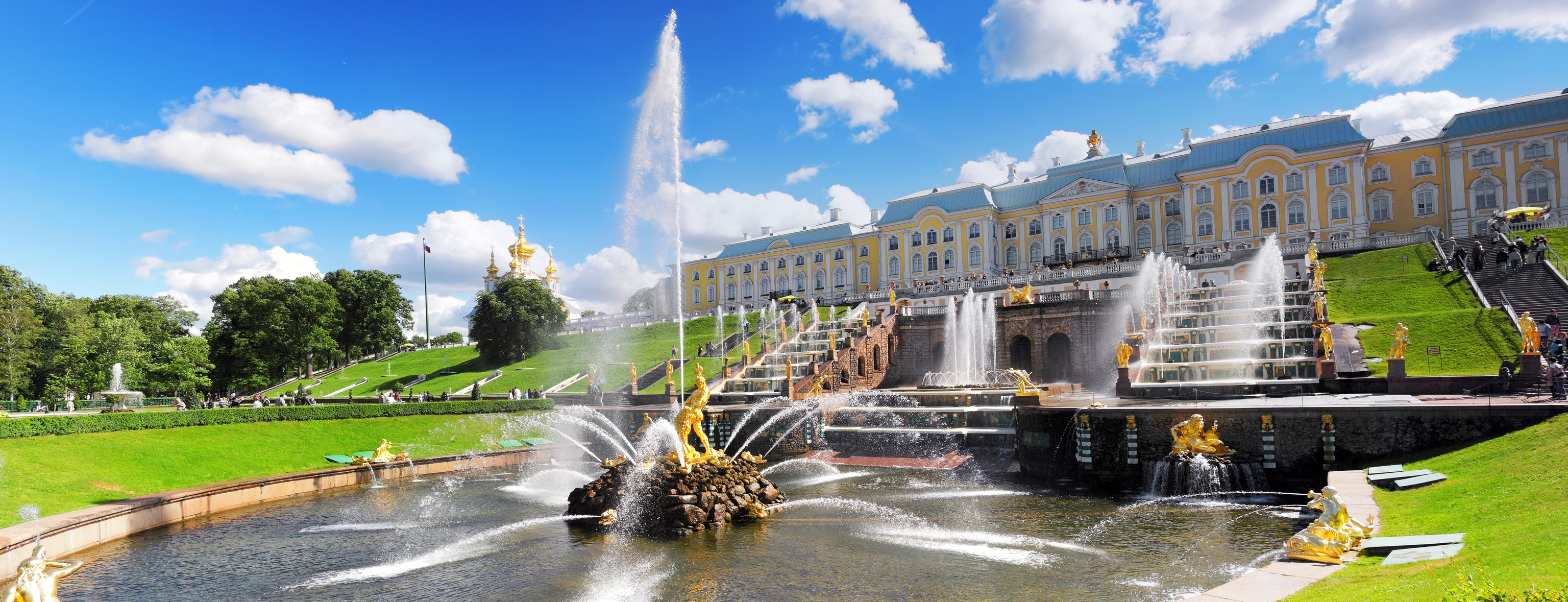
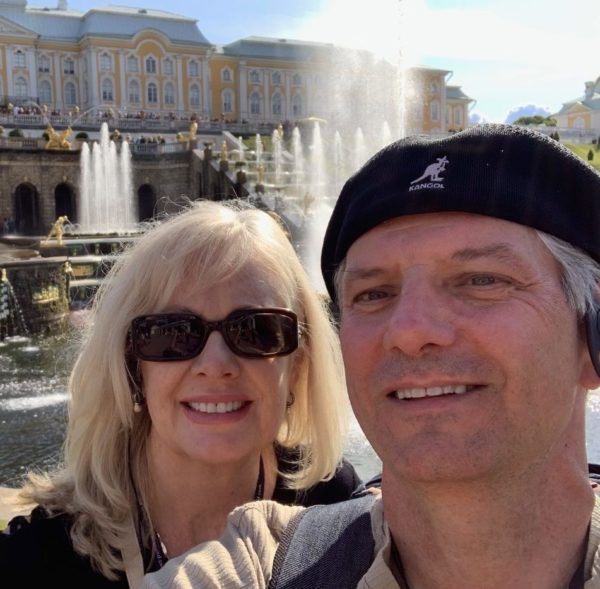
Larry & Audrey Ketchersid
2019 Volga Dream Platinum
Story #1. Volga River Cruise – Moscow to St. Petersburg
The ship that would take us the on the Volga River was the MS Volga Dream (more details and floor plan of the ship can be found here). The ship can hold about 100 people, and reports were that our cruise had about 80. This was one of the main reasons we opted for this cruise other than Viking or Uniworld – the smaller count of fellow passengers. The other big reason was that this Moscow to St. Petersburg cruise housed people in hotels in those big cities during the few days in both. This cuts down on time being transported from the ports into the cities. Some people would rather unpack once and stay exclusively on the ship. We’d rather been in the cities we visit so we can walk around in the mornings and evenings and explore more.
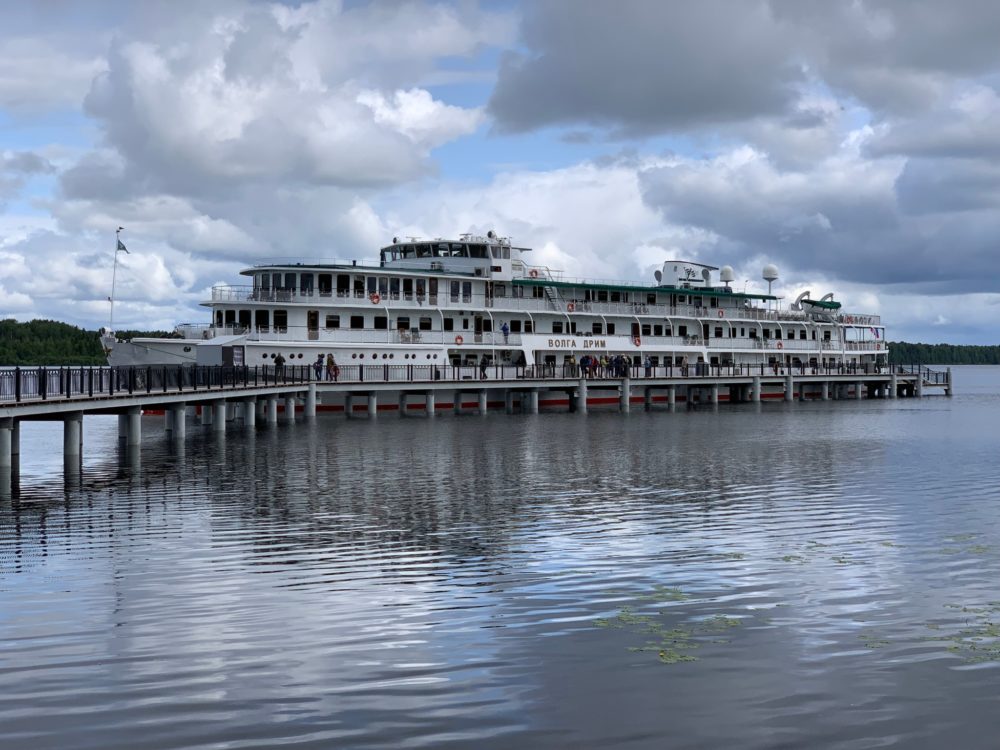
The Volga Dream ship
The MS Volga Dream has a crew of about 60 and they were by far the best part of the cruise. They were all friendly and engaging, spoke good English and were willing to put up with my really poor Russian.
The ship had a restaurant, a lounge on the top deck, a very small exercise room in the middle of the bottom deck (and by small I mean a rowing machine, a treadmill and a bike, all in a row!), a couple of bars and a library area. The rooms had no balconies, but there were ample sitting areas along the sides and in the back of the boat. We watch several nice sunsets off the back of the ship.
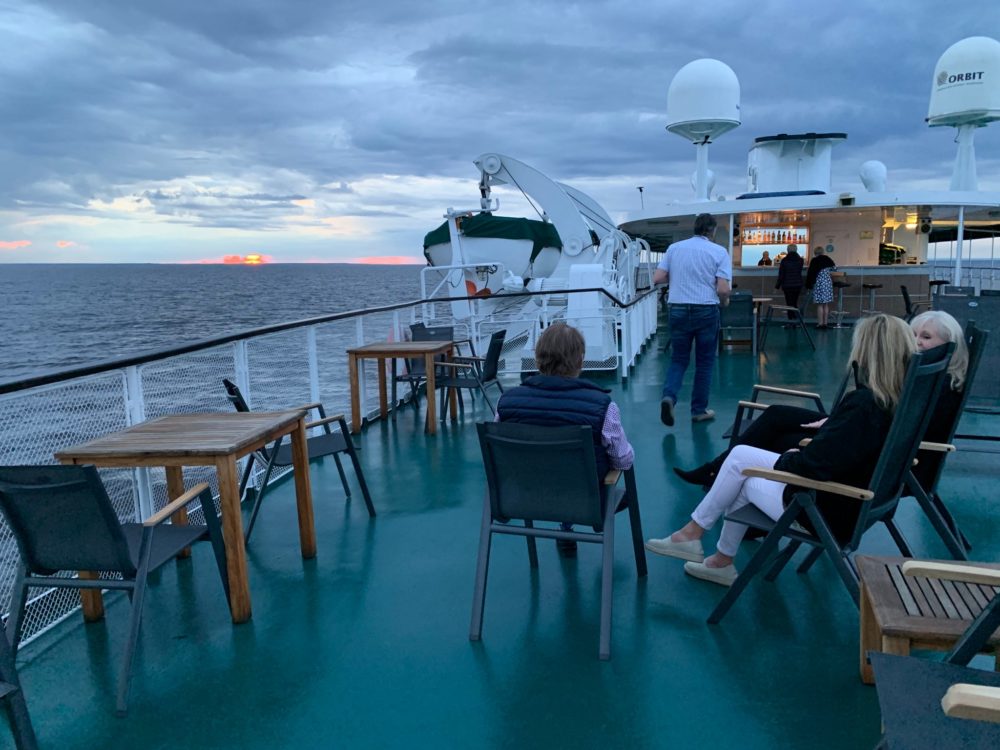
There was also a library on the third level, and behind it a seating area where Audrey and I watched it rain, warm and dry.
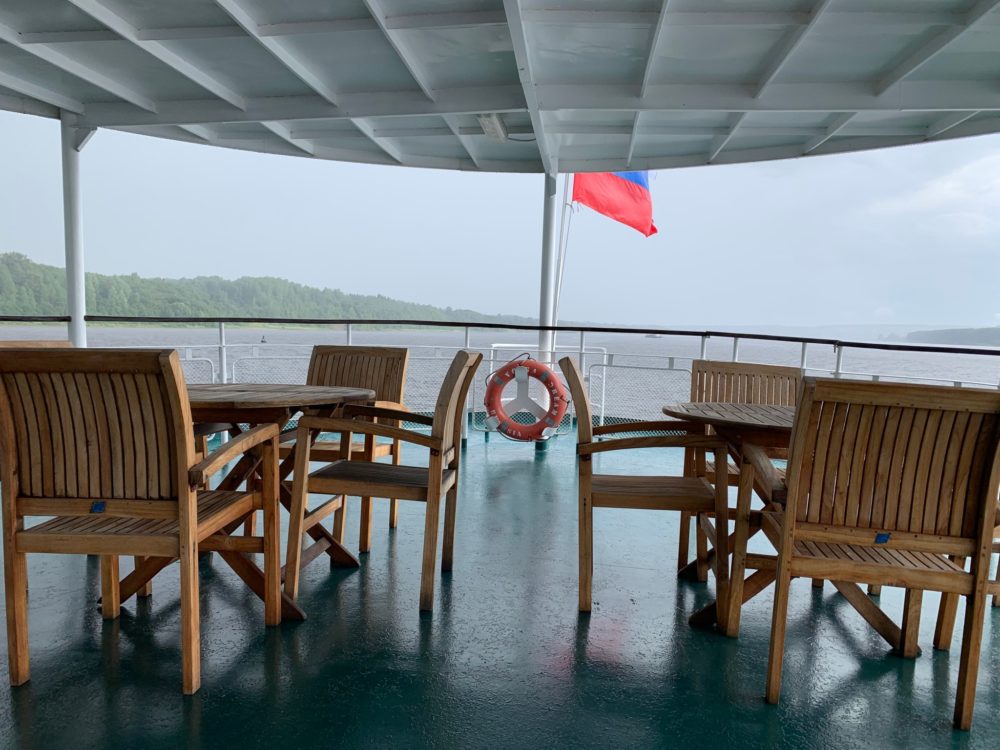
It was a smooth ride, except for on the bigger lakes where the weather got a little rough. And while the ship covered a lot of ground, we were occasionally passed by hydrofoils. They were older looking, but they still moved faster than our Volga Dream.
The Volga River Cruise Route
This map depicting our Volga River Cruise route was posted in the hallway leading to the dining room onboard. Except for the one stop depicted in the north of Lake Lagoda, it shows the route our cruise took. The cruise went Moscow – Uglich – Yaroslavl – Goritsy – Kizhi Island – Svirstroy – St. Petersburg, departing Moscow on the evening of July 7 and arriving St. Petersburg the morning of July 13.
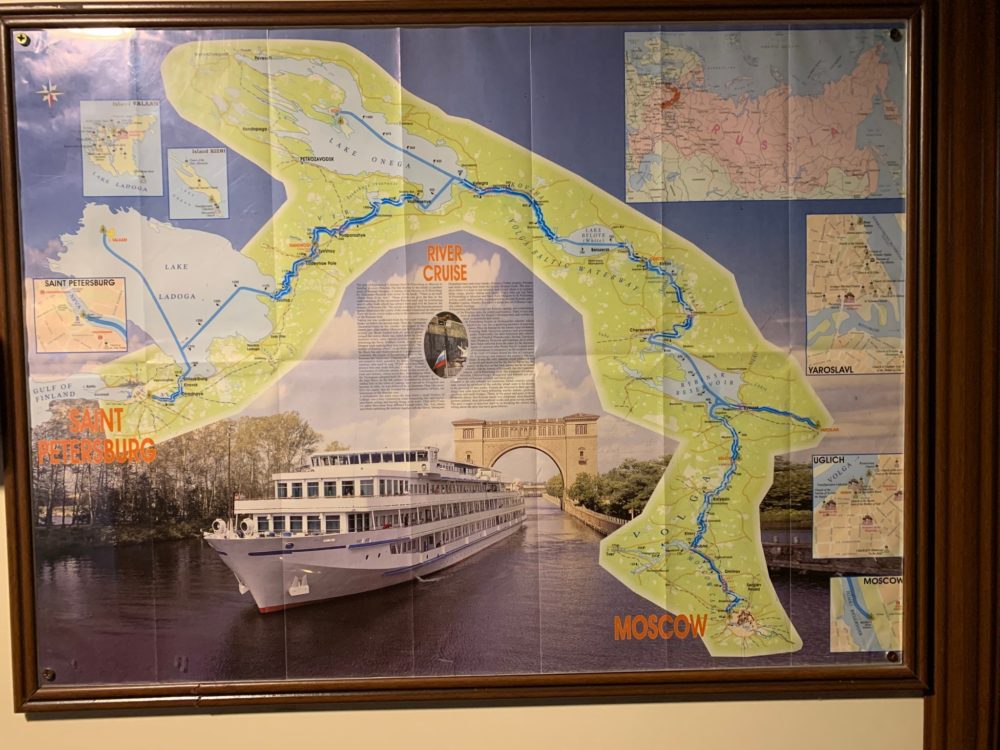
Through people on the tour and through readings I’ve found that somewhere between 40-50% of the population of Russia lives along the Volga River. With the population of Russia about 145 million people, there’s about 70 million people who live in the Volga basin. With the populations of Moscow and St. Petersburg about 12 million and 5 million respectively, the remainder is spread out over one of the largest countries in the world. On our journey north we would observe some large stretches with no apparent population.
The cruise wasn’t exclusively on the Volga River. It started on the Moscow Canal to get to the Volga. The ship also went:
• along the Sheksna River,
• over the White Lake,
• through the Volga Baltic Waterway,
• along the Vytegra River,
• through Lake Onega,
• along the Svir River,
• across part of the massive Lake Ladoga and
• finally along the Neva to dock in St.Petersburg.
Some of the lakes we crossed were large enough that at times the shore could not be seen. Two of them, Lake Ladoga and Lake Onega, are in the top twenty of the list of largest lakes in the world. Both are in the north, close to St. Petersburg and Finland, near the end of the cruise. The water was a bit rough at times in those two crossings, but tolerable. The crew mentioned they’d had rougher.
This cruise is only provided in June – October. In the winter months parts of the path are completely frozen. We were quite lucky with the weather, only getting a few spots of rain, with cool temps that we Texans soaked up.
The route went through 17 unique locks (since we backtracked from Yaroslavl, we hit that lock twice!). Each of the locks were different in architecture. As we explored the ship the first night (after shutting down the bar!) we came to the prow of the ship just as the first lock approached. This lock was Lock 6 on the Moscow Canal. During the evening the ship passed through five more locks on the Moscow Canal on the way to Uglich. Some of the locks were just wide enough for the ship, and occasionally woke us in the night when the ship bounced against a side of the lock.
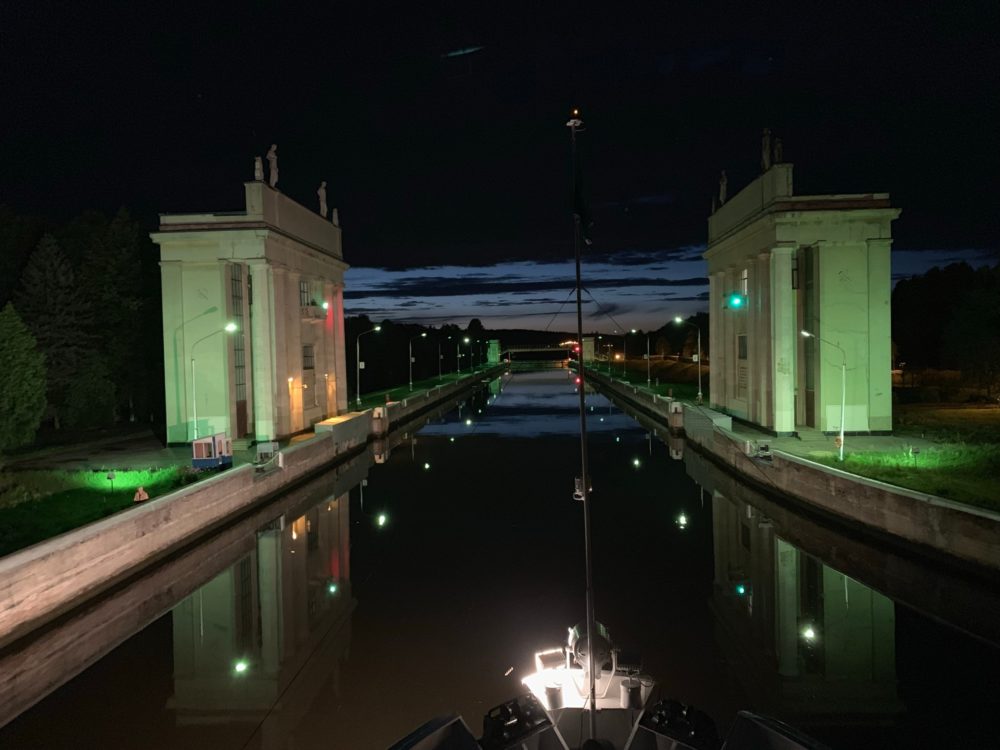
Uglich
On board there were talks about each stop, Russian history lectures and language lessons, and occasional arts and crafts discussions. And, my personal favorite, lunch!
Our first stop on our Volga River cruise was the town of Uglich in the Yaroslavl Oblast (oblast is similar to State or Province), a town of about 40,000 people. The ship passed through the Uglich Lock as it approached the city. We arrived in Uglich at 5:30pm.
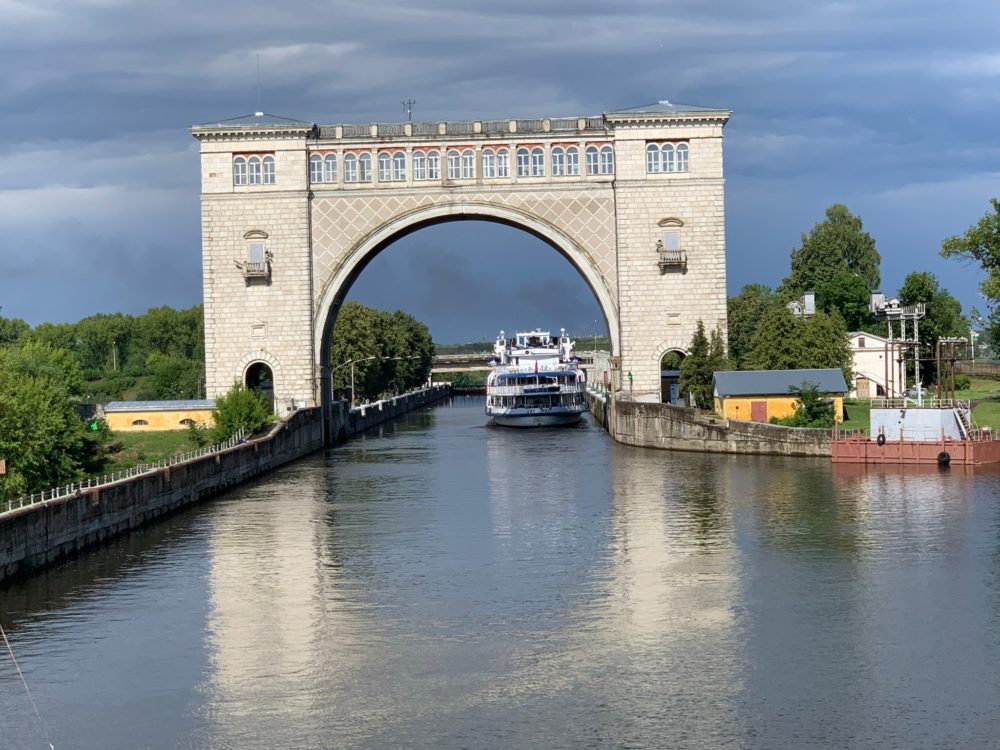
The main attractions are the two churches in the Uglich Kremlin. Below is a photo of the most famous of them, the Church of St. Dmitry on The Blood. After Ivan the Terrible’s death in 1584 his youngest son Dmitry was banished to Uglich. On May 15, 1591 the 10-year-old tsarevich Dmitry, the last heir of Ivan the Terrible, was found dead with this throat cut in the palace courtyard. The tsar’s chief advisor Boris Godunov was suspected of foul play, but Dmitry’s death was ruled an accident. As Dmitry was the last scion of the ancient Rurik dynasty, his death lead to the crisis in Russian history known as the Time of Troubles.
In 1690 the Church of St. Dmitry on the Blood was built on the spot where Dmitry was murdered.
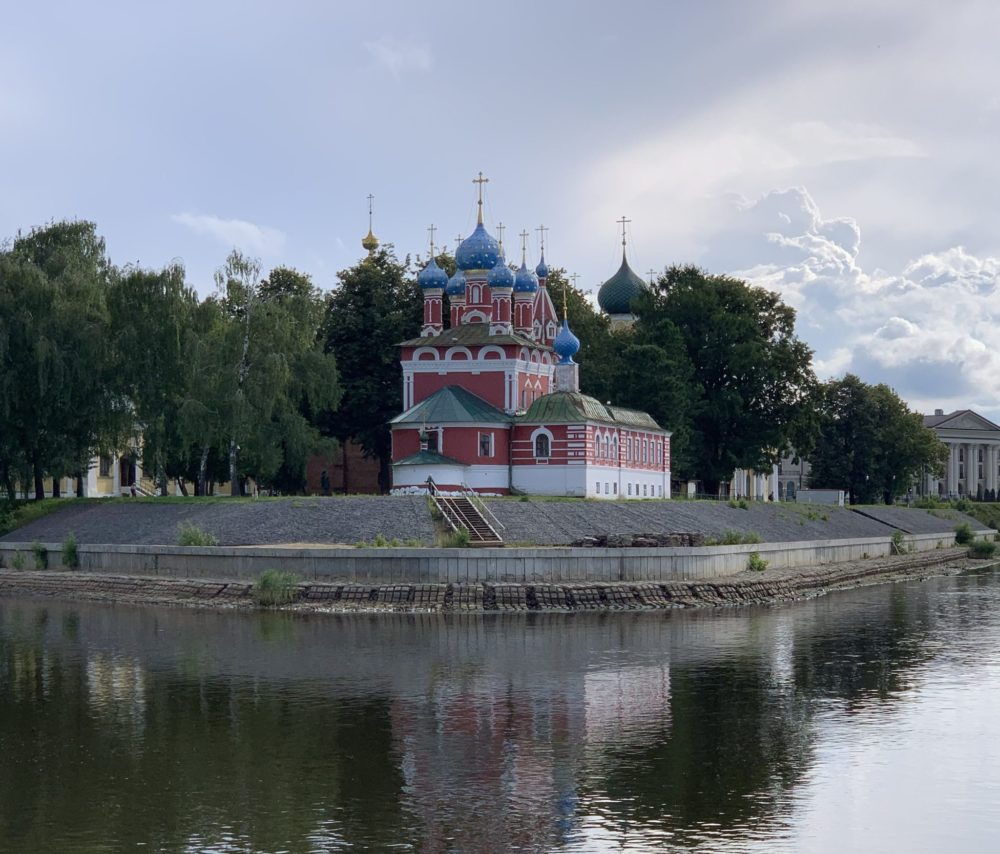
Our boat docked across the channel from the Kremlin adjacent to another boat that had already docked. We’d see this at several other places – to disembark, we’d walk through the middle of the other ship.
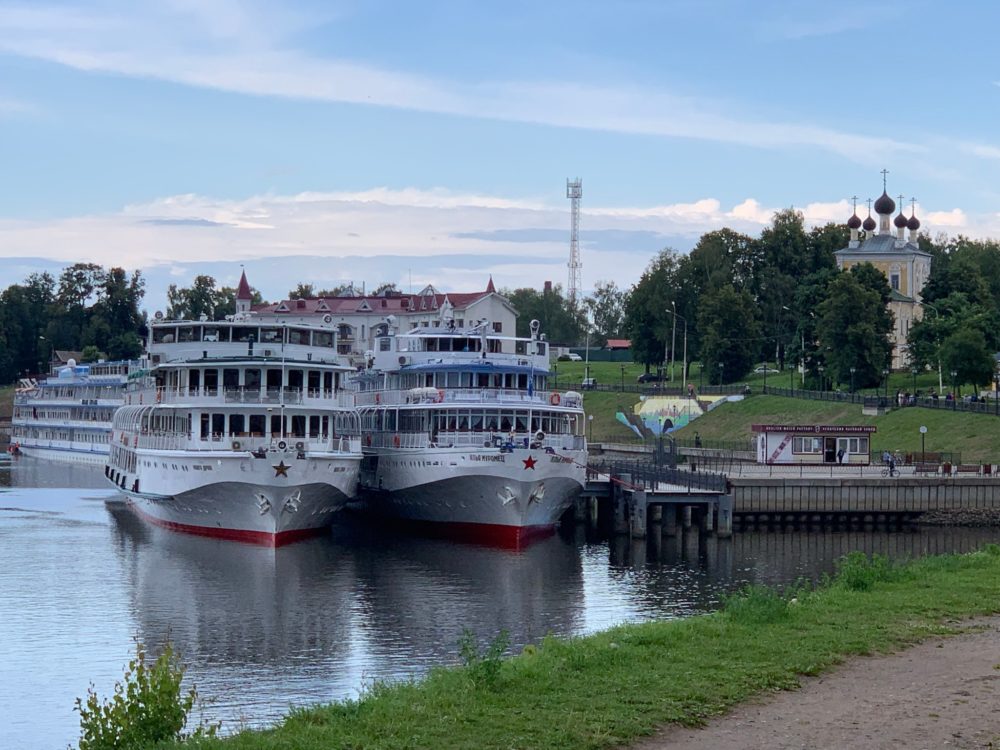
Below is a map of the small Kremlin area in Uglich. The Church of St. Dmitri on the Blood is depicted in its red and blue domed colors.
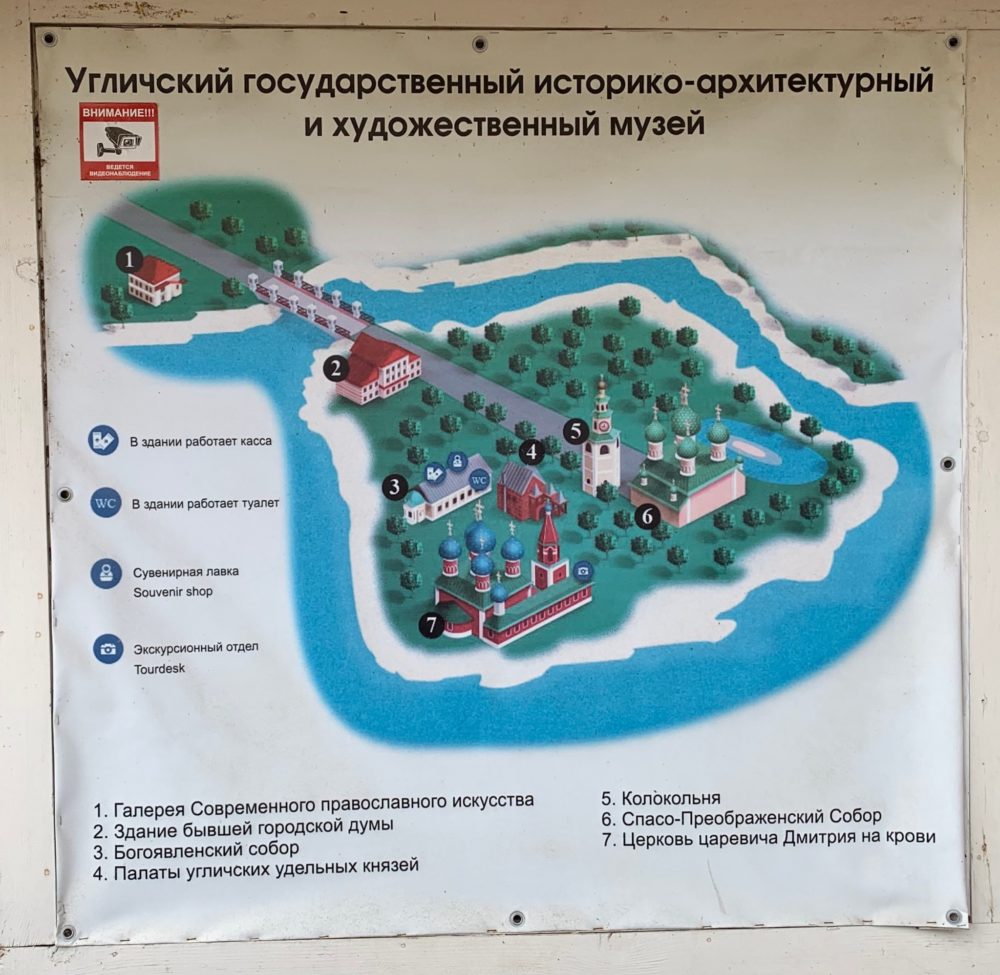
The first building that is seen while crossing the bridge into the Kremlin area is the Transfiguration Cathedral (number 6 on the map above).
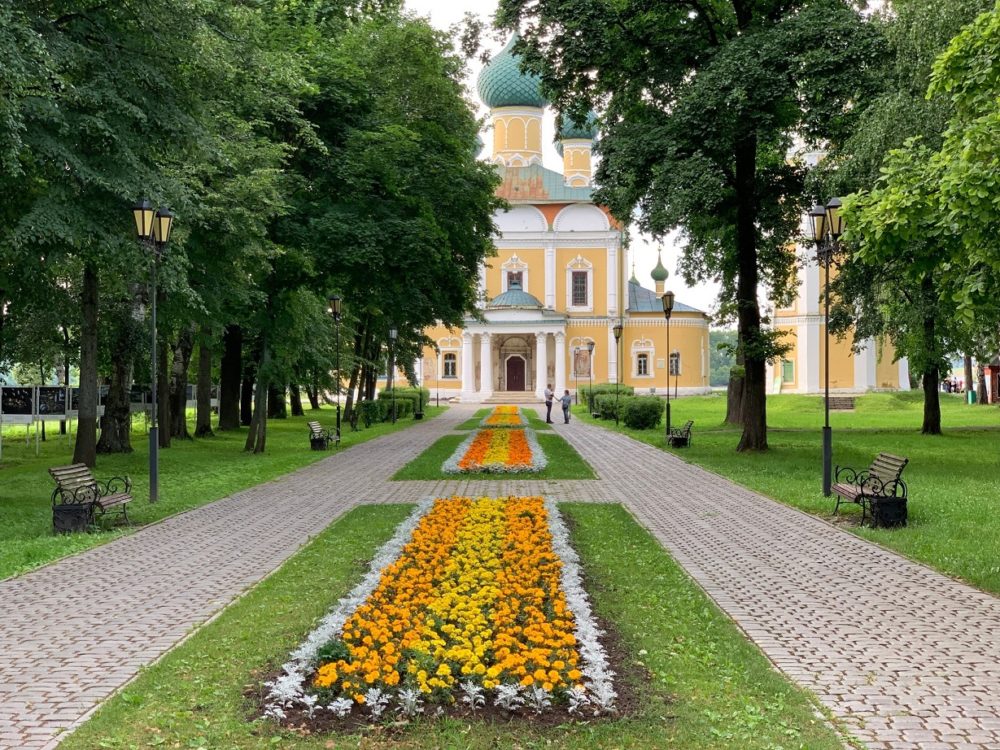
We walked to the right toward the Church of St. Dmitry on the Blood, which we entered first.
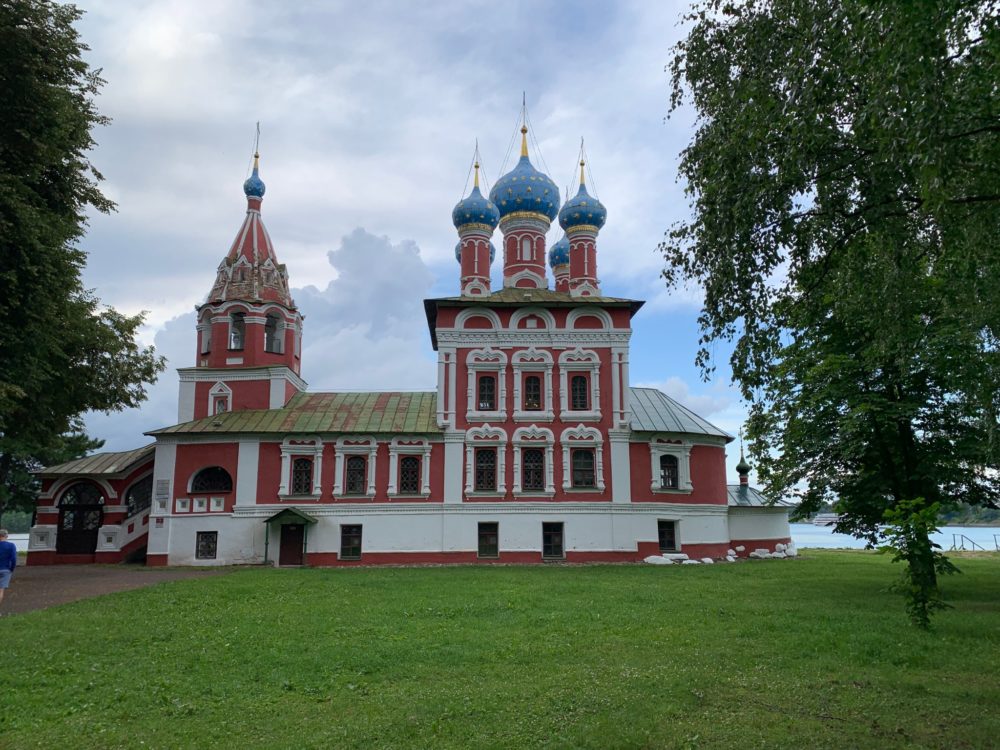
It is a small church so there was a bit of a wait. The crew of the Volga Dream had warned us that a storm might be coming up so we were glad to get inside the church.
I believe the wall below is painted to show the events of the day of the murder of Dmitry.
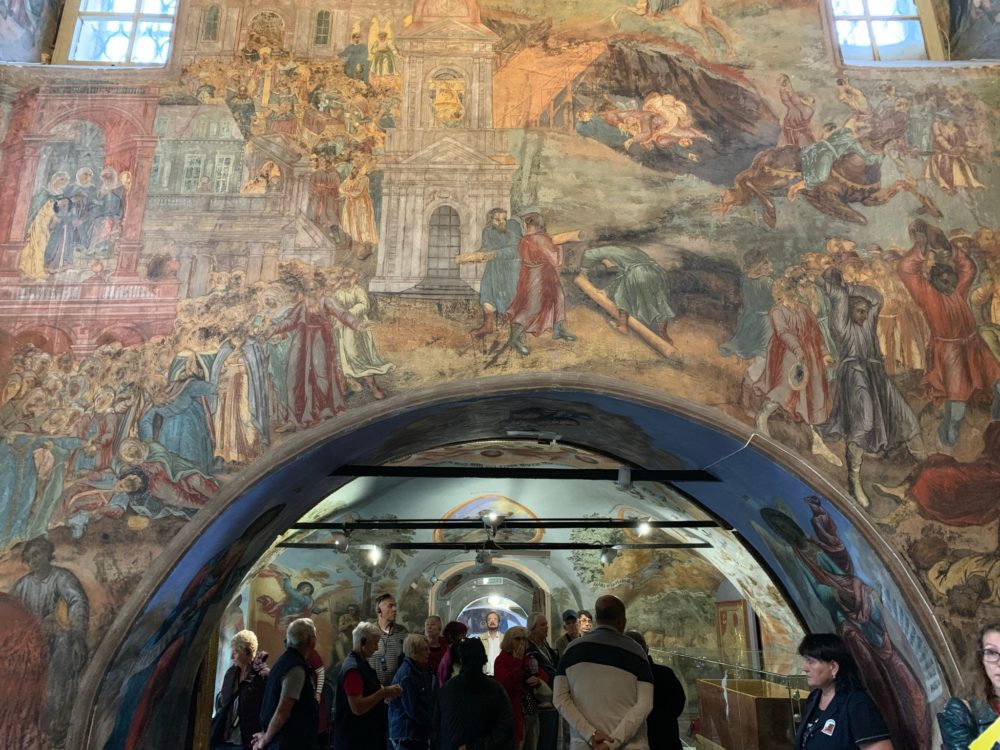
Every visible piece of wall inside the cathedral was painted, mostly in the 1700s.
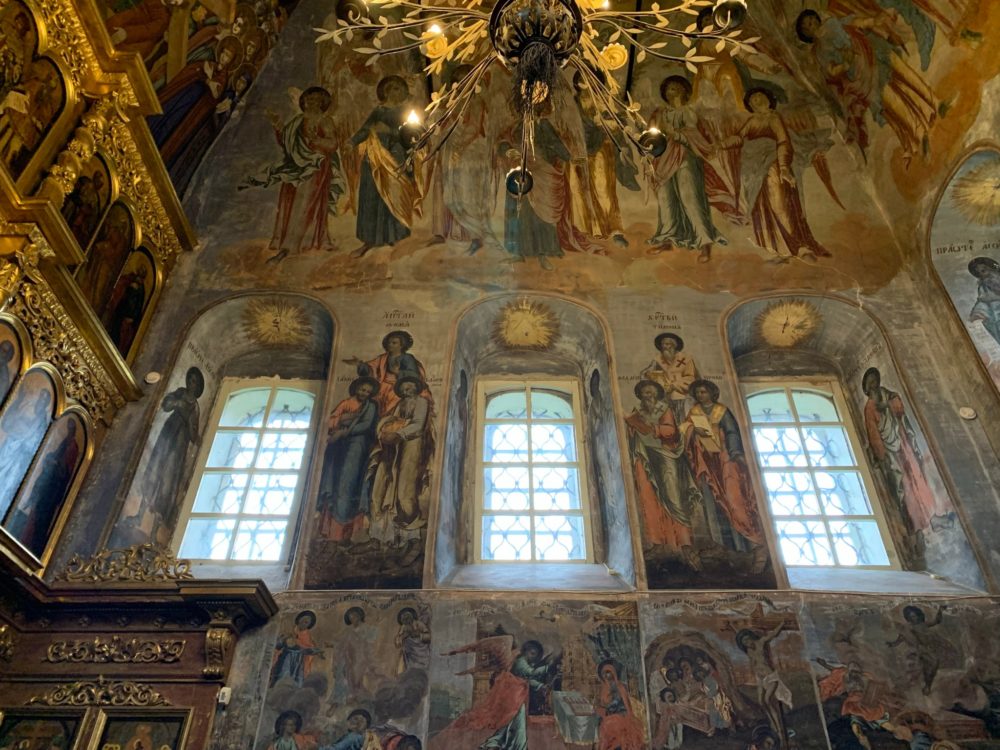
Below is the bell that was rung on the day of Dmitry’s murder. One translation I’ve found of the inscription on the bell states “This bell tolled the murder of right-believing tsarevich Dmitry. In 1593 it was sent from Uglich to exile to Tobolsk, to the Church of Savior, and later was moved to the clock of Sofia’s Chapel”
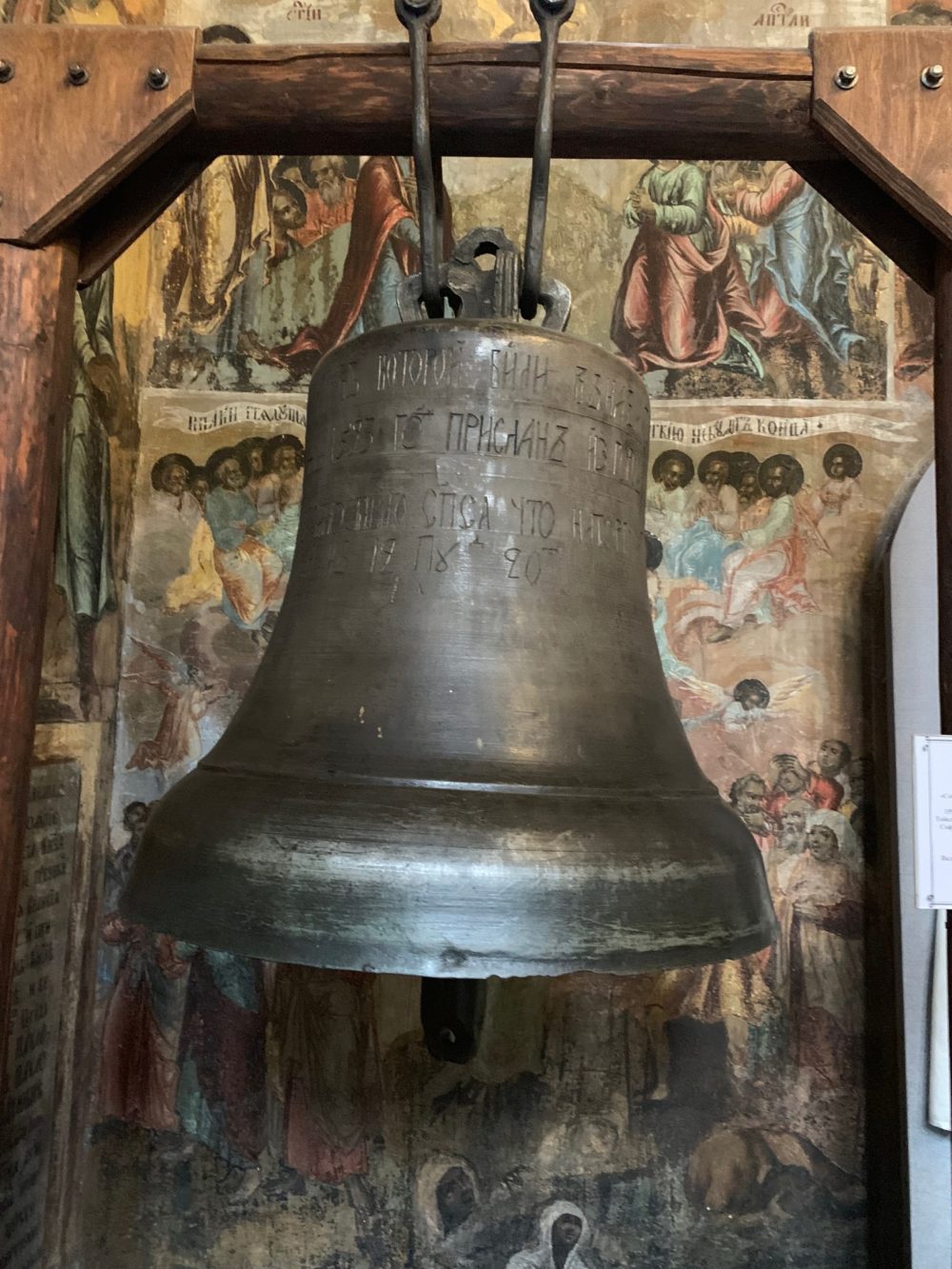
There’s also a very interesting door at the front of the cathedral, with intricate carvings.
Next we entered the Transfiguration Cathedral that we had first seen when crossing over the bridge to the Uglich Kremlin. It was a short visit as the storm appeared imminent. One entire wall of this cathedral was covered with individual paintings.
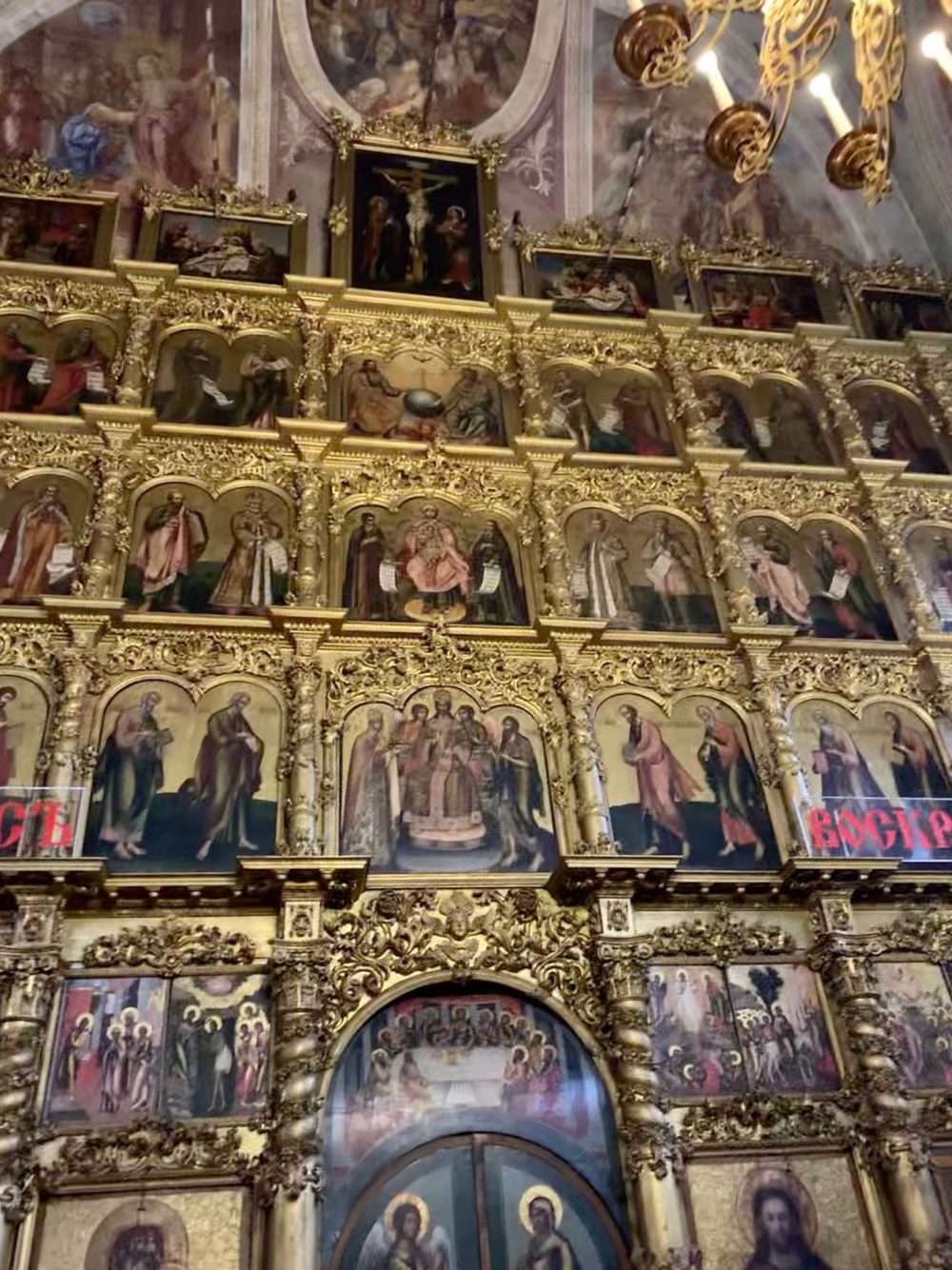
In our tours in Moscow, we heard about Russian icon paintings. Every subsequent stop on the Volga River cruise tour and in St. Petersburg appeared to have Russian icons. We looked forward to hearing our guides say the word “icons”. 🙂 But frescoes and Russian Iconography are what the Russian art is renowned for. Part of this was that, unlike Europe, there was no Renaissance in painting style. Here is an article that I wish I had read before our trip about how to look at Russian icons.
Our time in Uglich was limited. The ship arrived at 5:30pm and we were expected back on board at 7:45pm.
Overnight we transitted through one lock (the Rybinsk Lock) and on July 9th at 8:30am we docked in Yaroslavl…
Yaroslavl
As you can tell from the map of the Volga River cruise in an earlier section, the cruise headed east, a bit off course, to get to Yaroslavl. The ship would back track over water already covered. But Yaroslavl was an excellent place to visit. It was the largest town outside of Moscow and St. Petersburg that we would encounter, with a population of 600,000. It’s historic center was a UNESCO site. It had beer (which I purchased and brought more on board!). And THERE WAS DANCING!
Each of our stops on the cruise had a different guide, and our guide for Yaroslavl was excellent. I believe her name was Lara (the hint was Dr. Zhivago) and she was a teacher at the local University.
Yaroslavl is one of the oldest Russian cities, founded in 1010, 150 years before Moscow. The city sits where the Volga River and the Kotorosl River meet. It is, of course, named after Yaroslavl the Wise. The city’s symbol is the bear. It took a lot of searching, but as you can see in the photo below, we did find the bear.
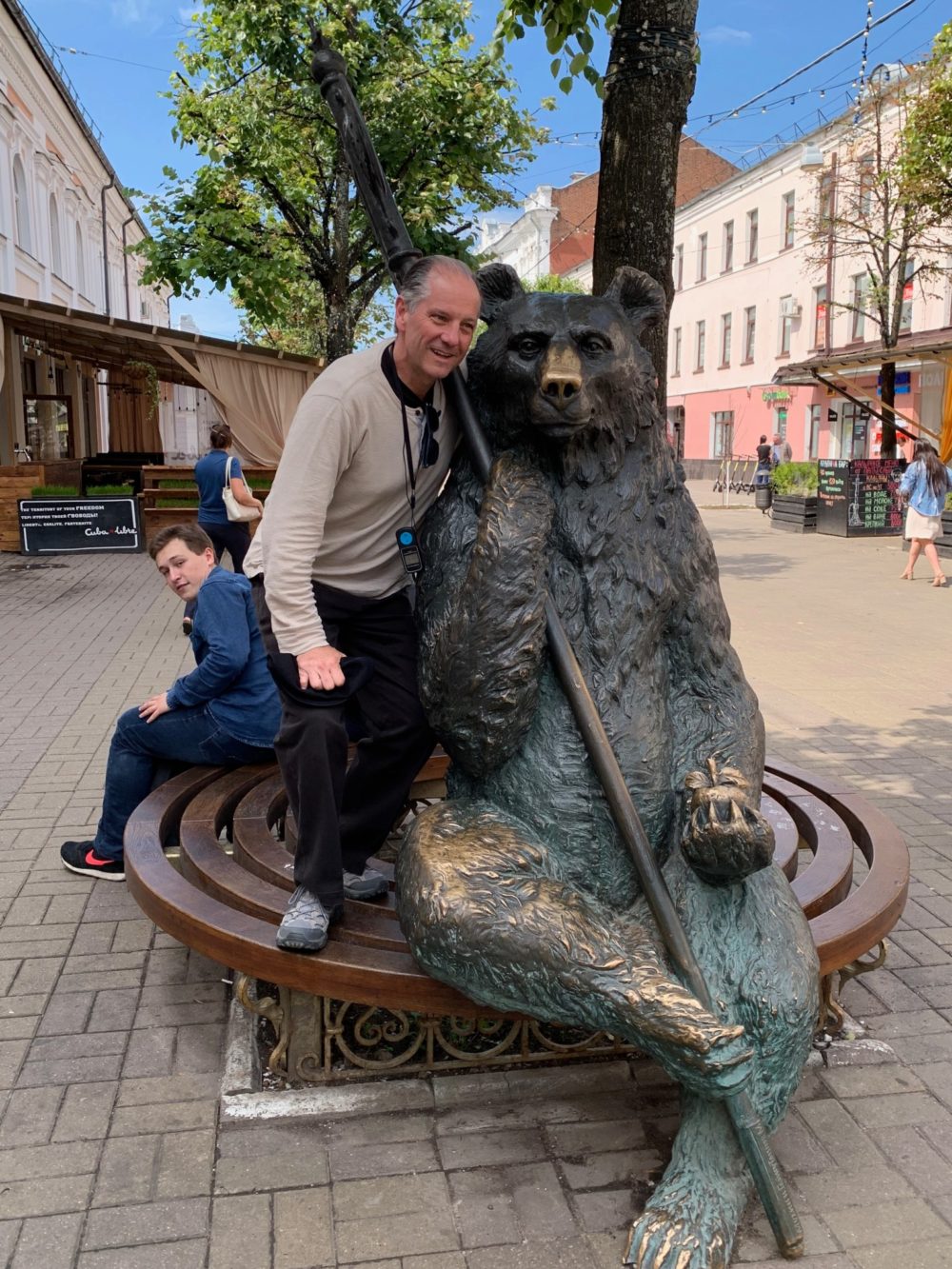
Our first stop on our tour was an excellent World War II memorial with an eternal flame. We walked through the park to the church in the background, which was the Cathedral of the Assumption. We walked past the memorial to a small building where a local men’s a capella group sang.
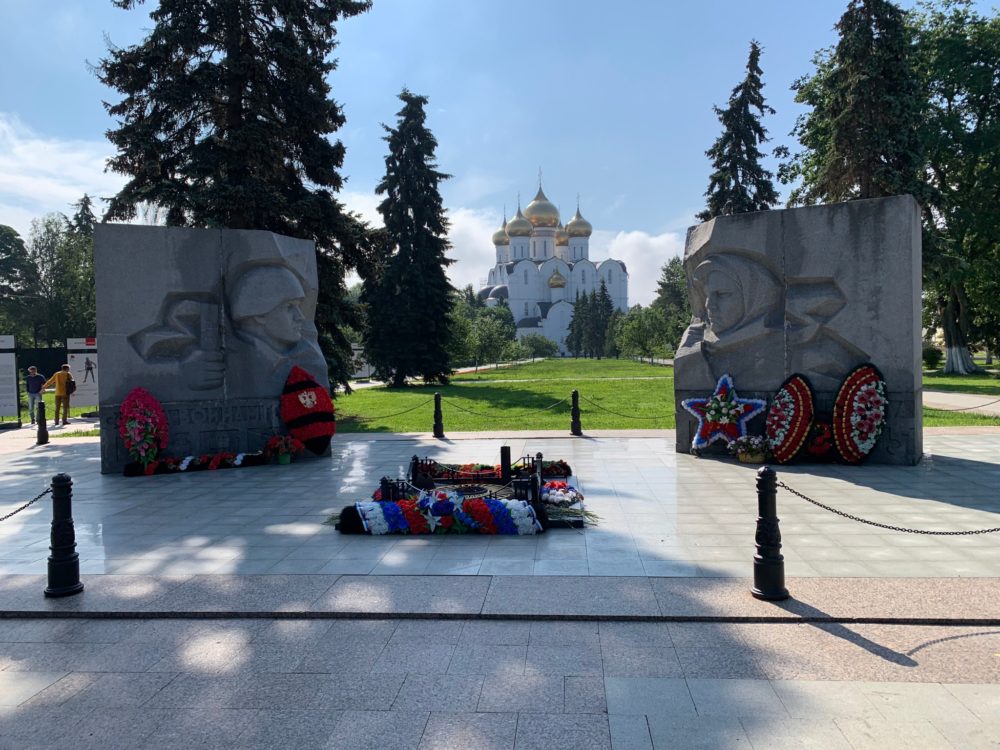
The Church had been destroyed and rebuilt four times, and the current version was very recent. In front of the church is a sculpture named “Trinity” by Nikolai Alexandrovich Mukhin.
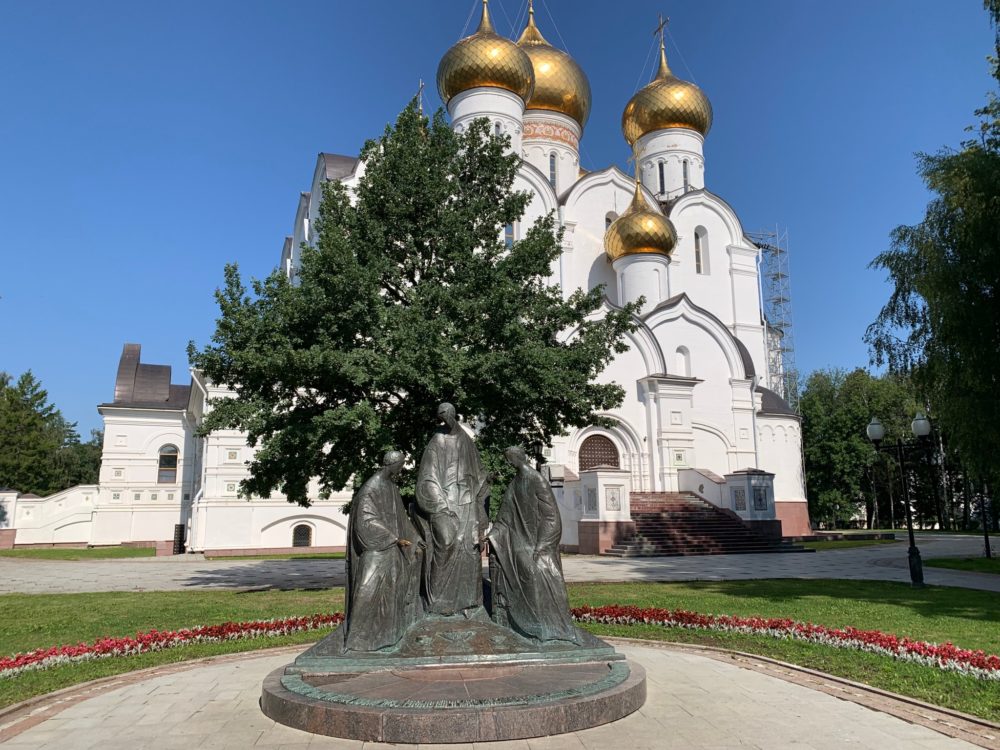
The 1000 year anniversary of Yaroslavl is celebrated at Strelka Park (Парк на Стрелке) located on a spit of land where the Volga River and Kotorosl River come together.
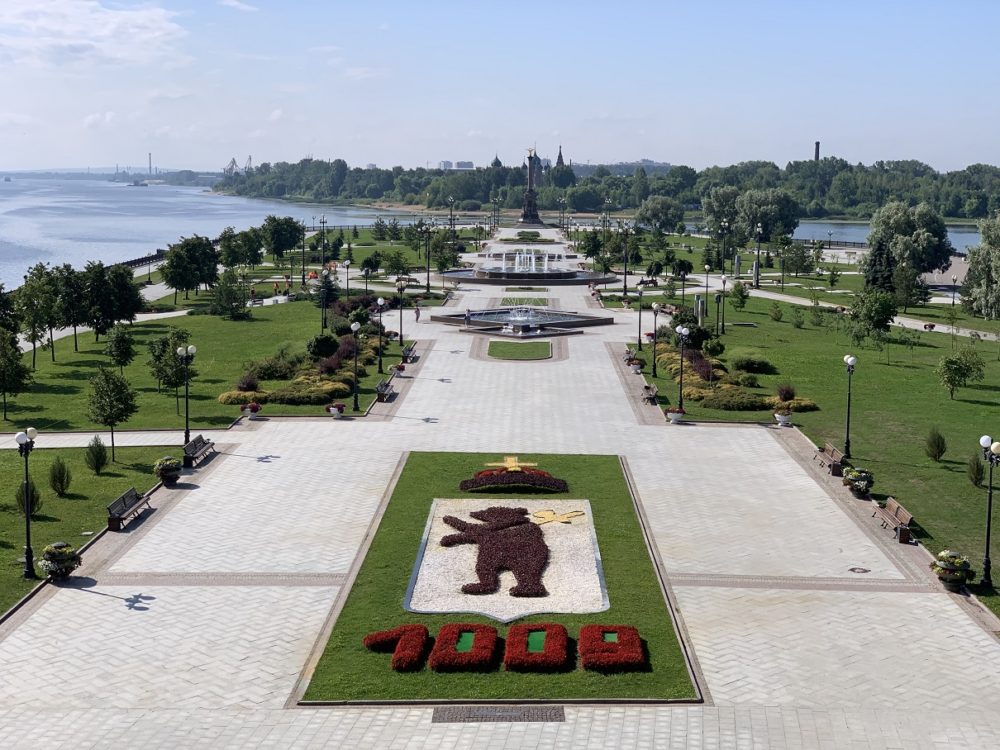
We continued through the Historic District to the Spaso-Preobrazhensky Monastery (the Monastery of St. Jacob Saviour), a complex with several churches, exhibitions and a massive belfry. The Monastery dates from the early 13th century and, like many of the structures we viewed, had parts of it rebuilt several times.
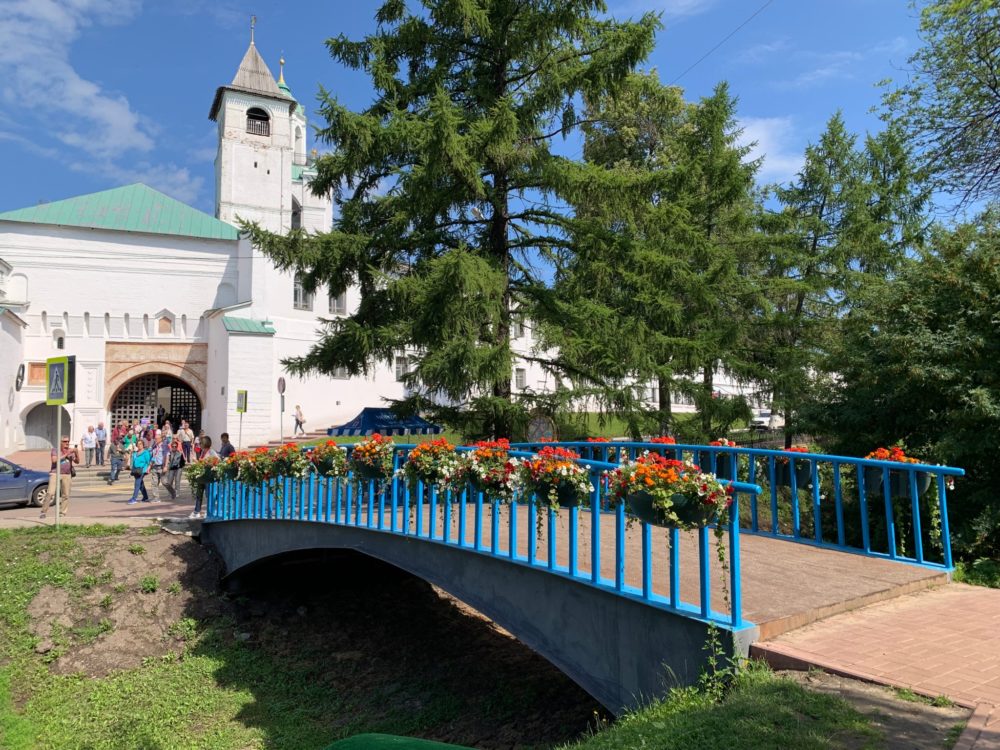
The park across from the entrance to the Monastery had a monument and trees with locks on them.
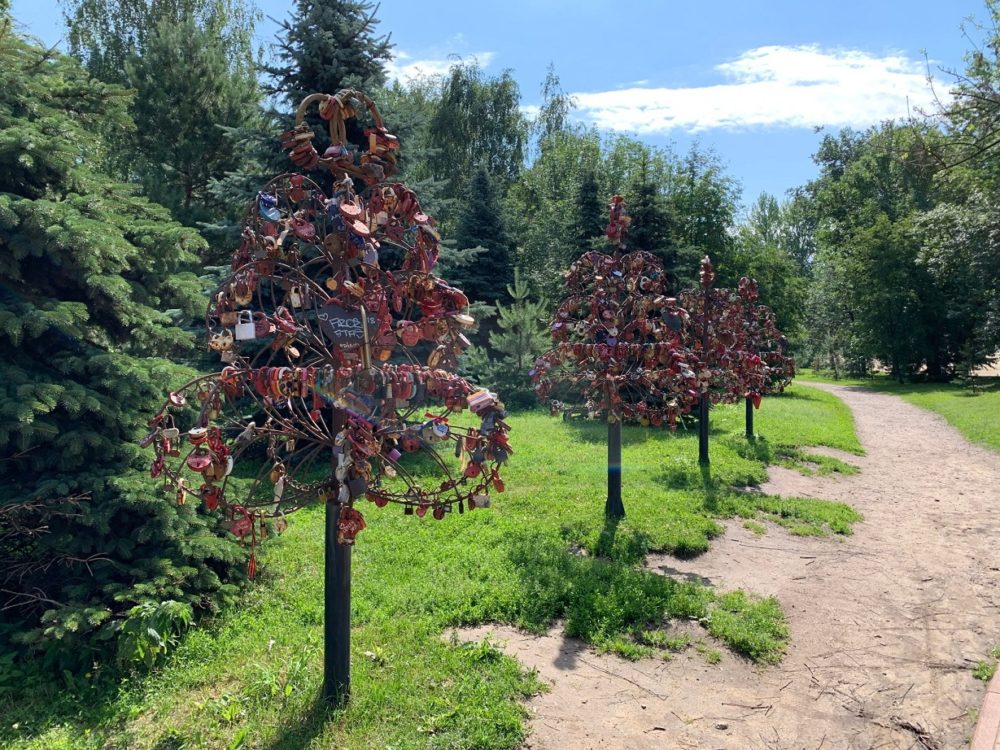
Just inside the gate to the monastery grounds is the belfry. It has 18 bells and is 32 meters tall.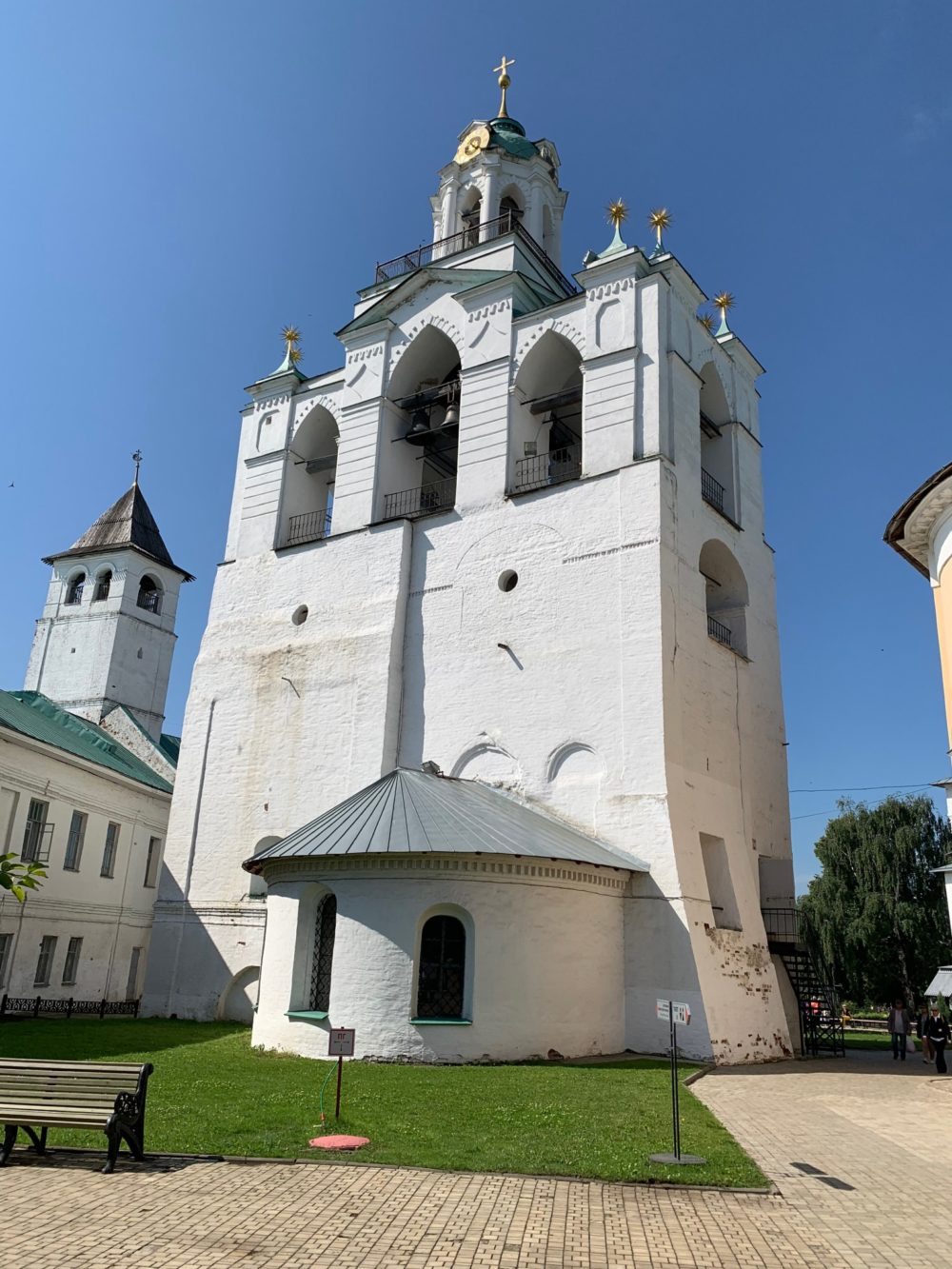
There are a lot of churches inside and around the monastery.
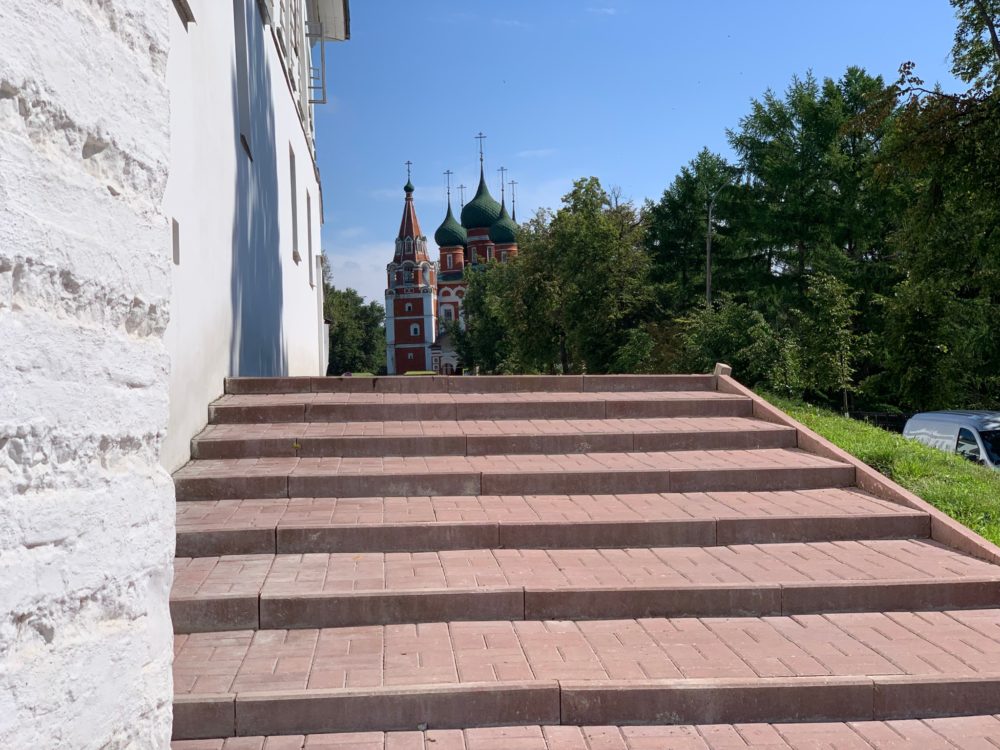
Then it was back on the bus for a drive to the city square. The first church in Yaroslavl is on that square and was dedicated to St Elijah as it was on this saint’s feast day that Yaroslav the Wise killed the bear and conquered the area. This version of the St. Elijah the Prophet’s Church was built between 1647 and 1650.
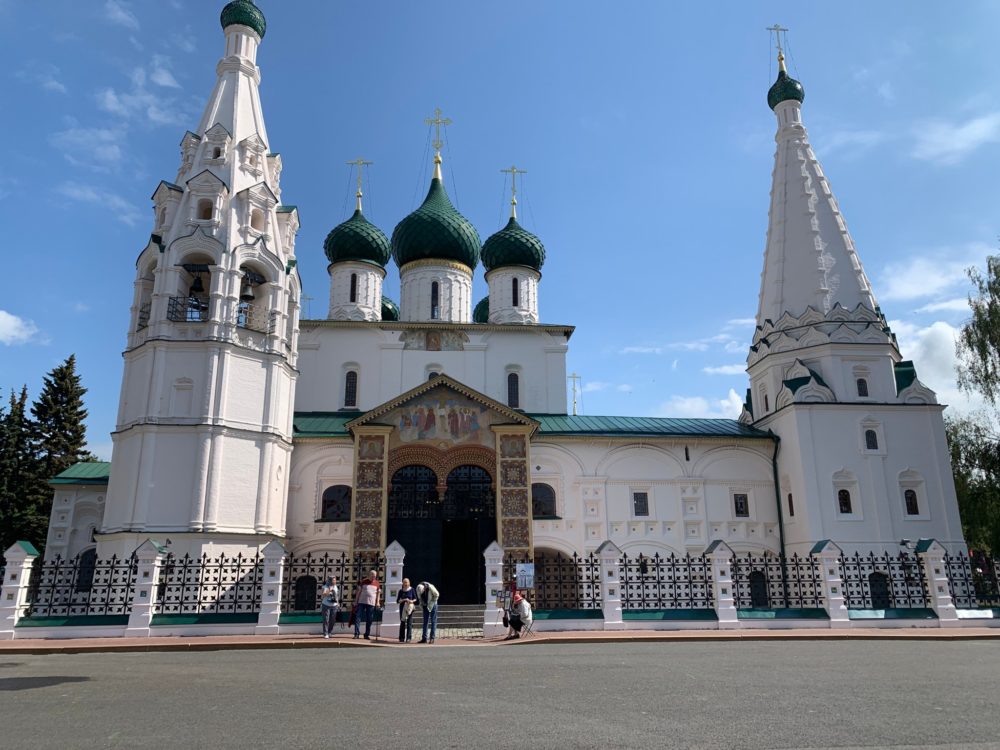
Inside the church the walls in the outer hallway are covered with frescoes from the 17th century.
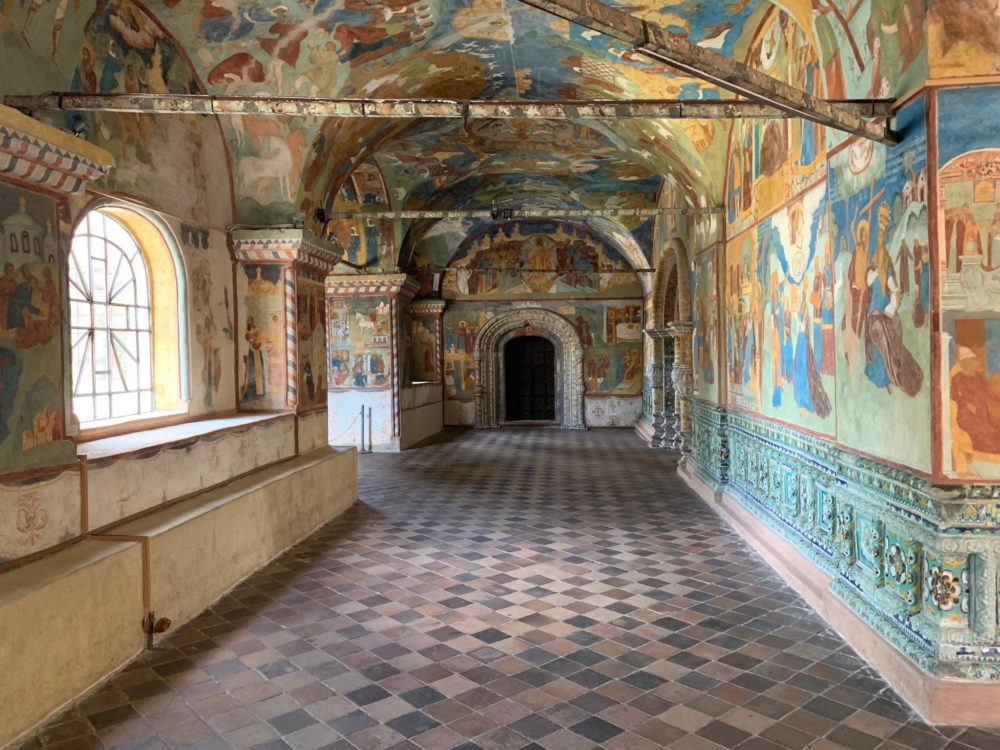
Each one of these frescoes could tell a story or two.
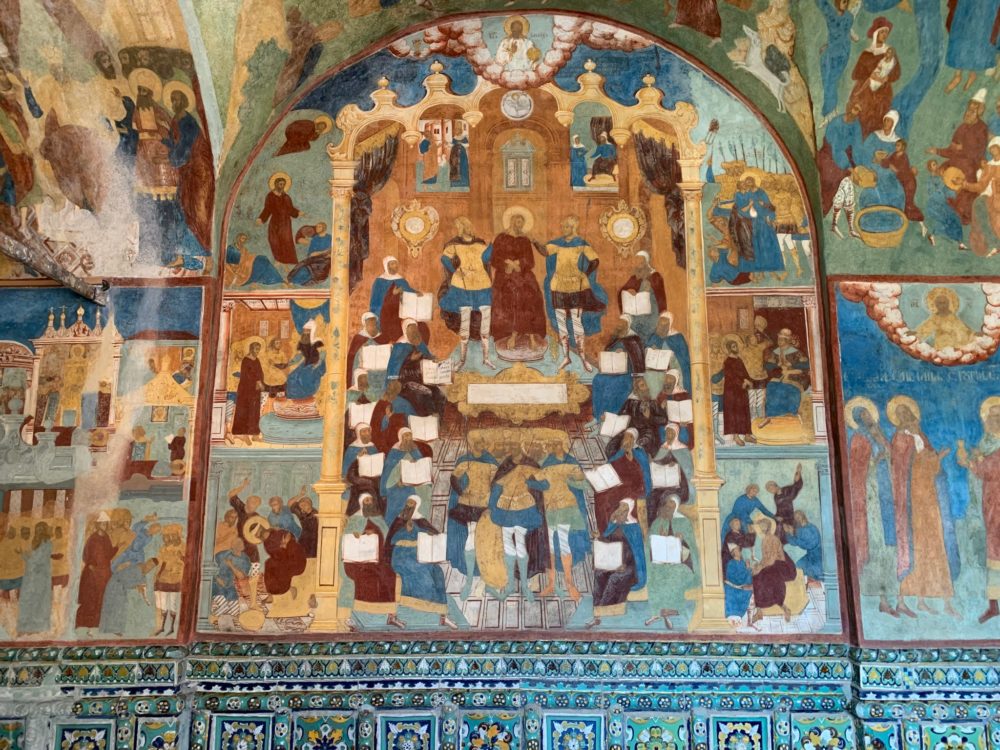
The inside of the chapel was very different from the external hallway. As can be seen in the photo below, the frescoes give way to lots of Russian icons (yay! more icons!).
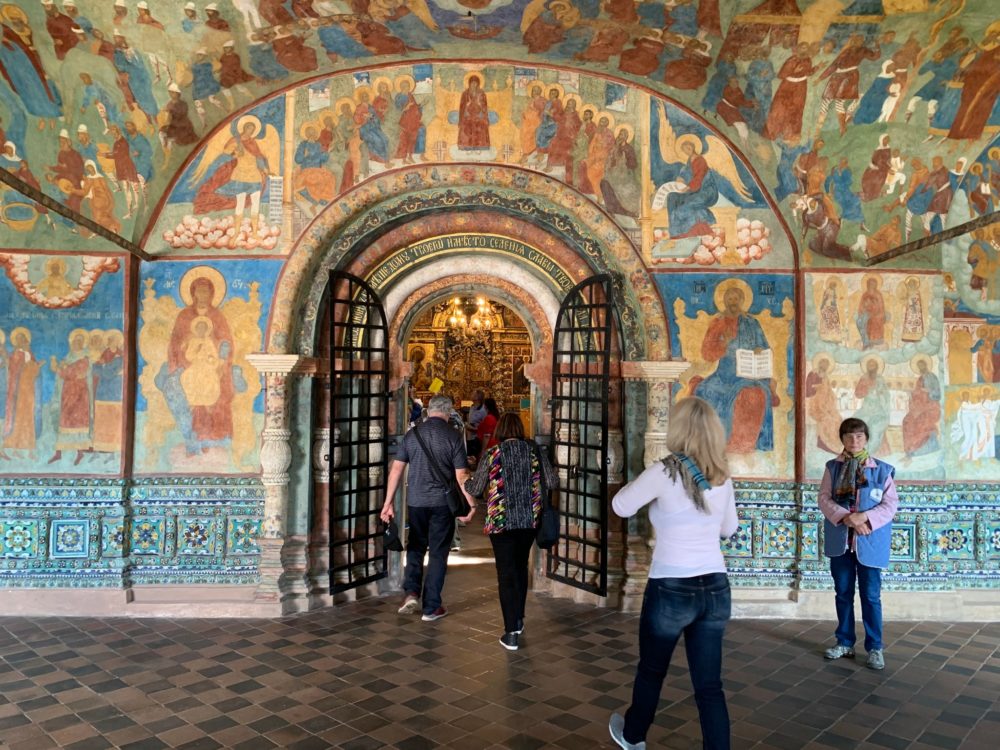
Inside the chapel, the icons were a stark contrast to the frescoes just out the doors. Our guide told us that Mary is always on the left, Jesus to the right. The icon to the right of Jesus is the icon of the church.
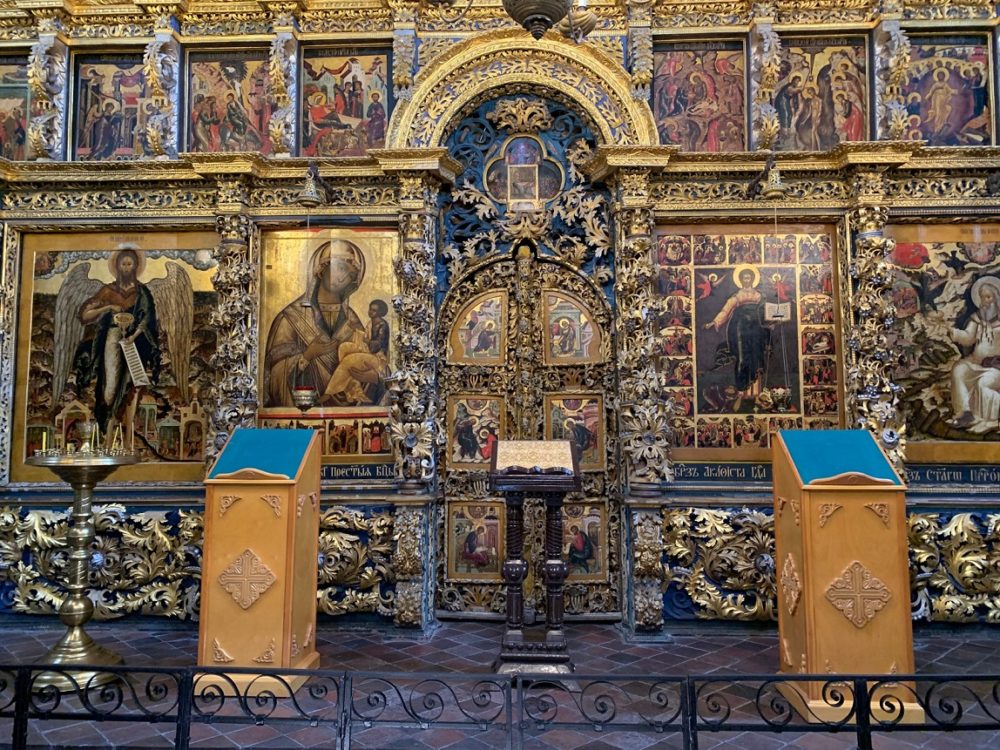
We then roamed the city for a bit, shopping for souvenirs and having a few local beers.
Our final stop on our tour of Yaroslavl was the Governor’s Palace. We were greeted by young ladies in period dress acting as daughters of the Governor from long ago, standing in for him to give us a tour of the Palace and its art work.
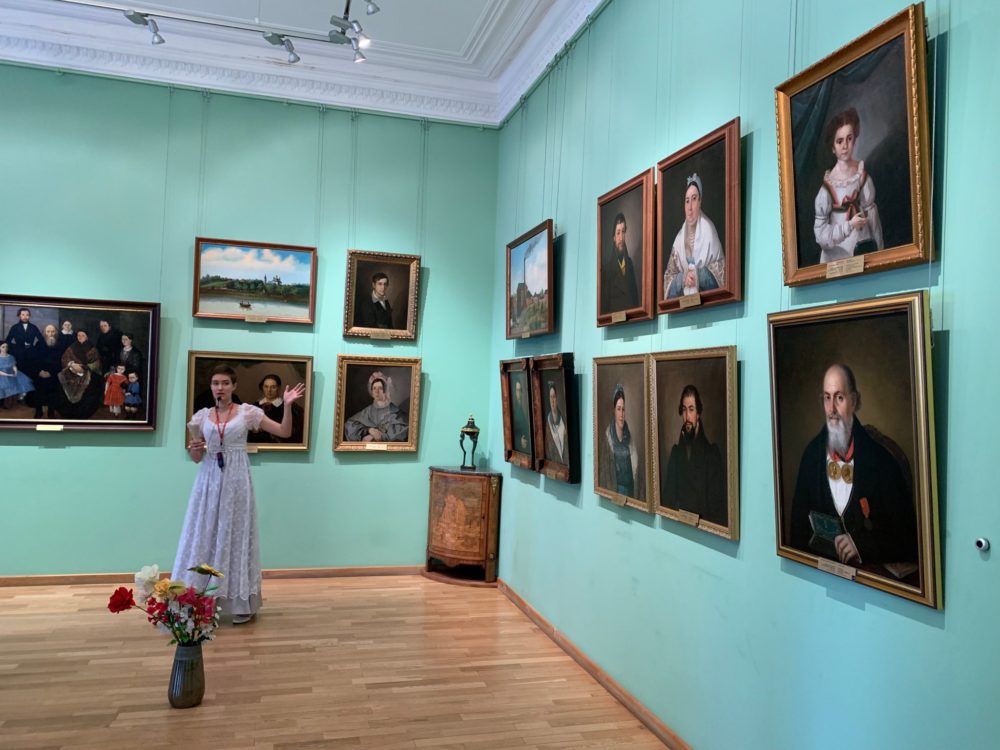
After all of the icons and frescoes (which were beautiful and historic) it was a refreshing change to see more modern paintings and sculptures.
After the tour of the palace, the young ladies brought all of the tour groups into a central room for a music and dancing exhibition.
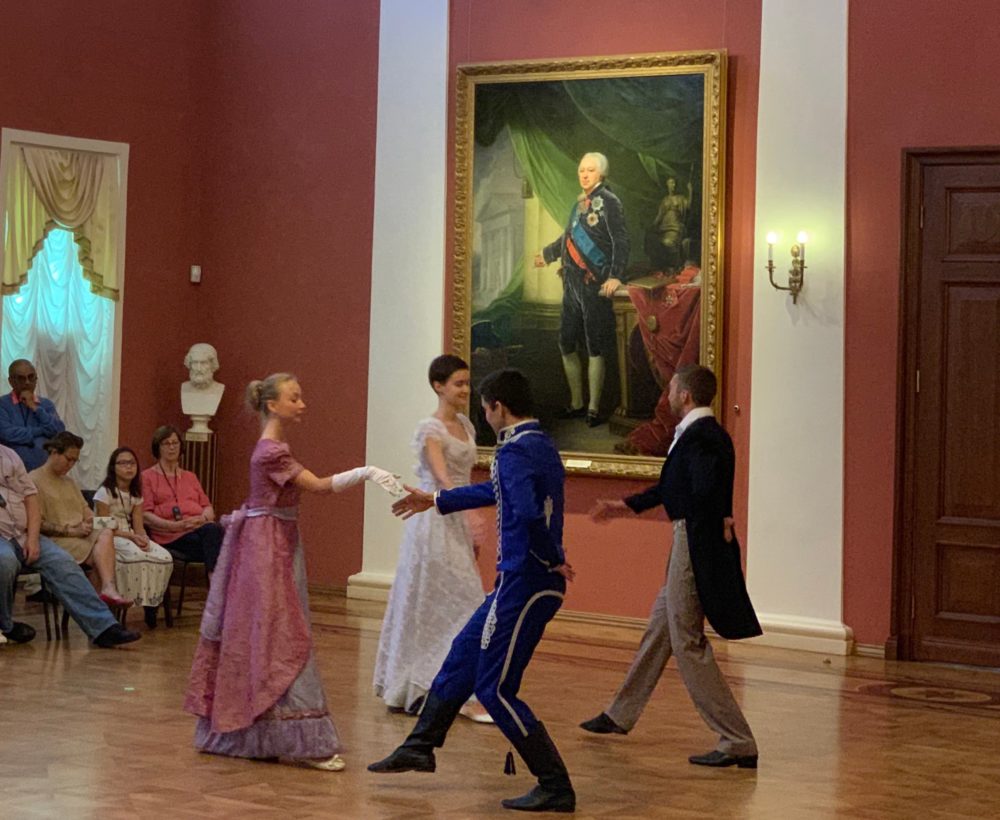
They then decided the needed to get audience members involved. Though I wasn’t her first choice, after being turned down by several of the gents, our tour guide grabbed me to dance with her…twice.
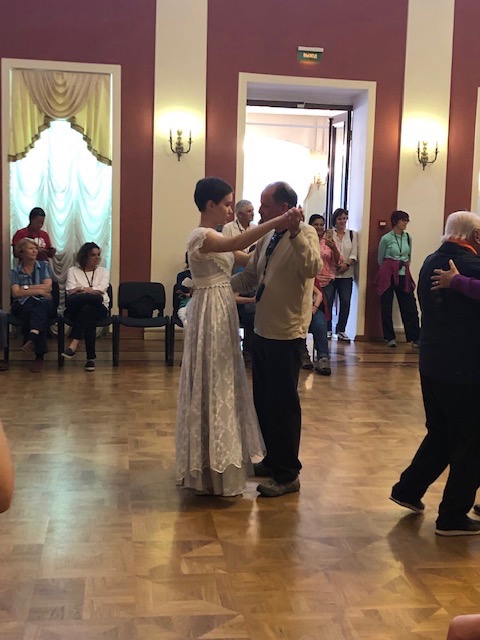
I’m sure you noticed my big hiking shoes, which I’m sure made a great impression on the dance floor. My young partner got out of character on the dance floor, told me she was attending the local university (where our guide was apparently a teacher) and knew some students there from Texas who were attending to learn Russian. She hoped to one day visit America, and I certainly hope she gets to visit.
One more shot in front of St. Elijah Church, and we returned to the bus and the ship.
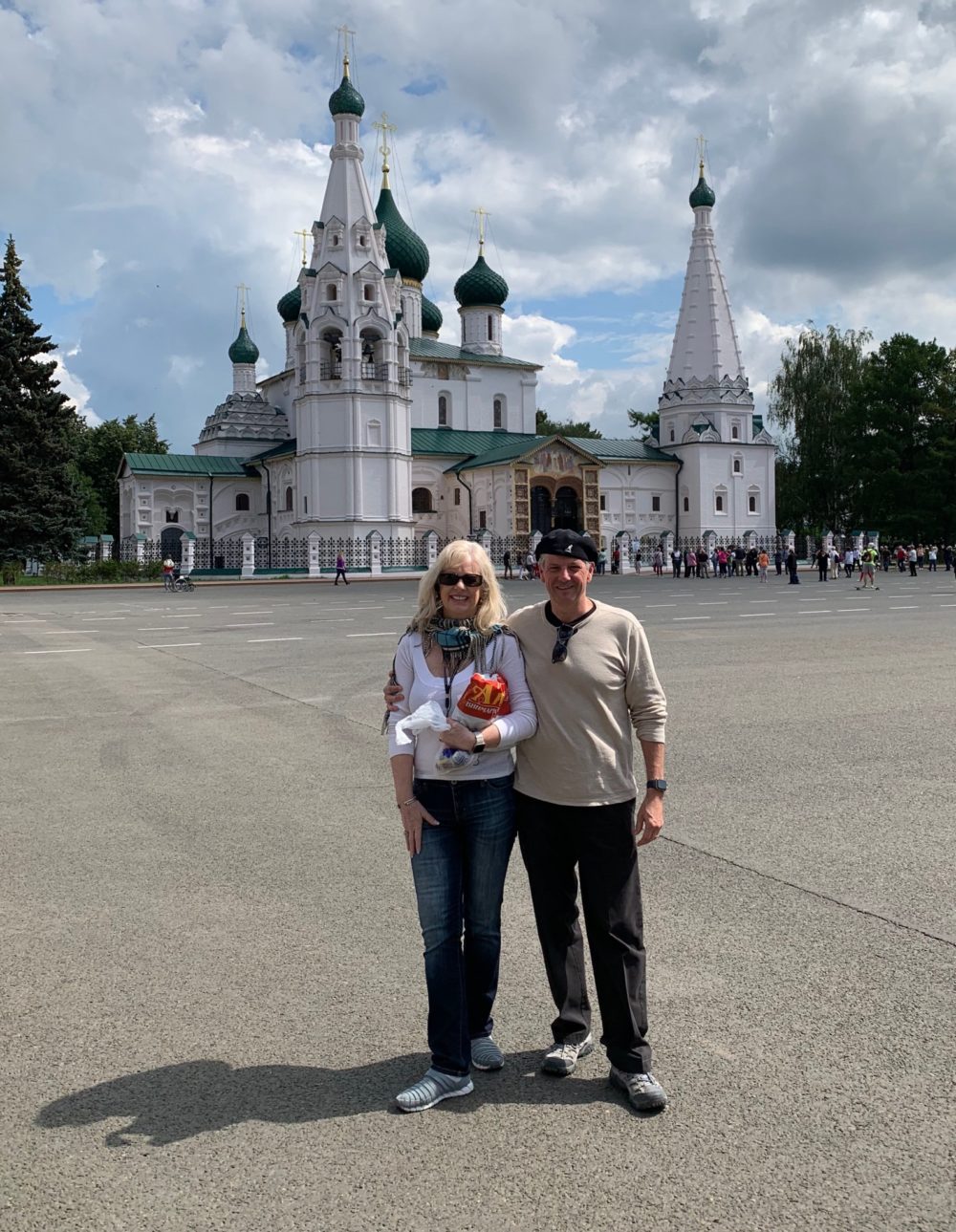
The path of our Volga River cruise back-tracked a bit, and then headed out into the Rybinsk Reservoir. Guarding the entrance is the statue of Mother Volga.
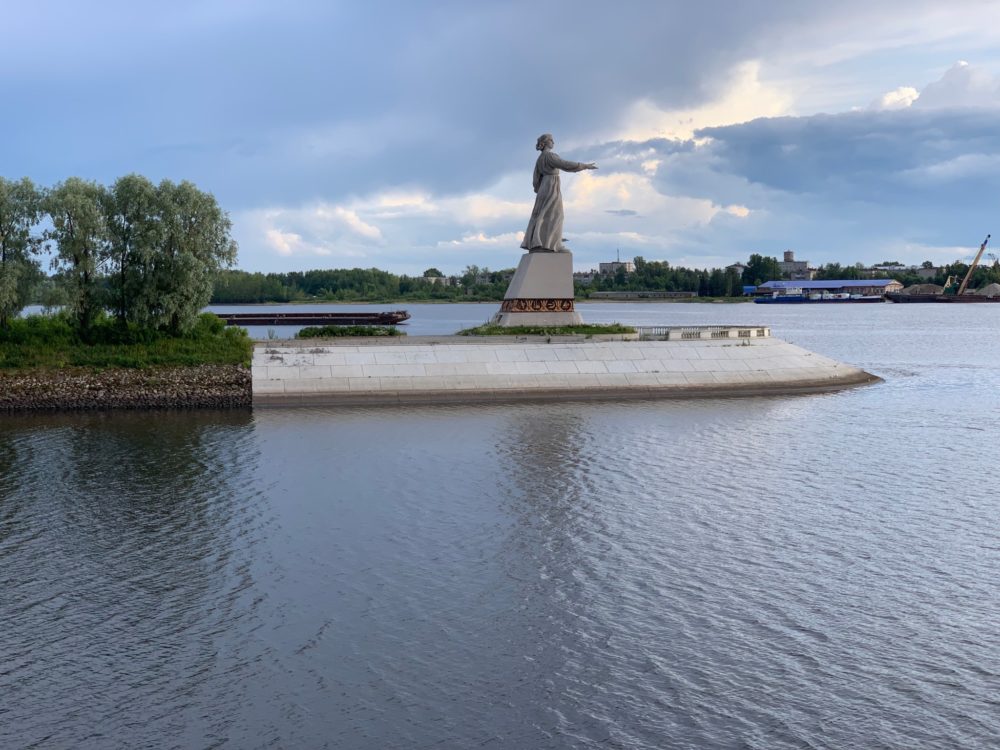
Goritsy – Ferapontov Monastery
The ship docked in Goritsy, and our group took a longer bus ride (30 minutes) through the Vologa Oblast to the Ferapontov Monastery. As with many of the other places visited on this voyage, the Monastery is a UNESCO World Heritage site. There are six surviving buildings in the Monastery, which is surrounded by a stone fence built in the 19th century.
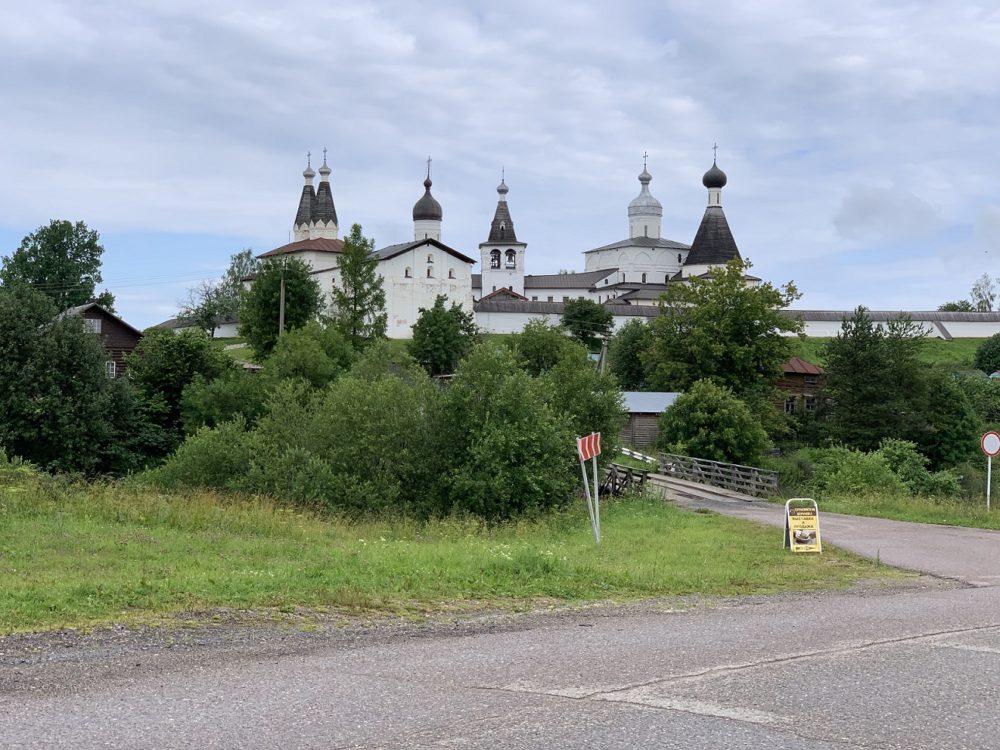
Though we were taken through a couple of the buildings to see artifacts, the main attraction was the Cathedral of the Nativity of the Virgin.
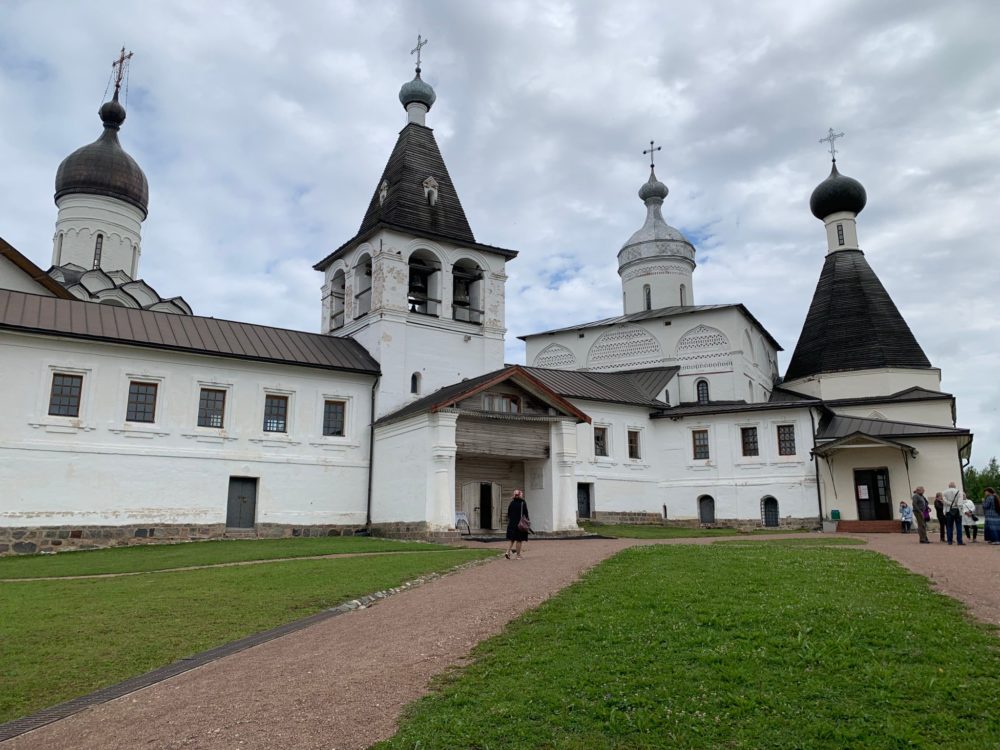
The frescoes in the Cathedral of the Nativity of the Virgin were done by the painter Dionisy in the 1490s. Dionisy also painted icons in the Cathedral of the Dormition that we saw at the Kremlin in Moscow. This cathedral is the last surviving medieval Russian church with fully painted walls. For that and other obvious reasons the caretakers at the Monastery were very careful with how many people were let into the Cathedral. We were initially going in, but held up because the temperature and humidity sensors in the Cathedral had risen above their safety levels with the number of people inside.
We stood outside while our guide pointed out some of the damage on the entry.
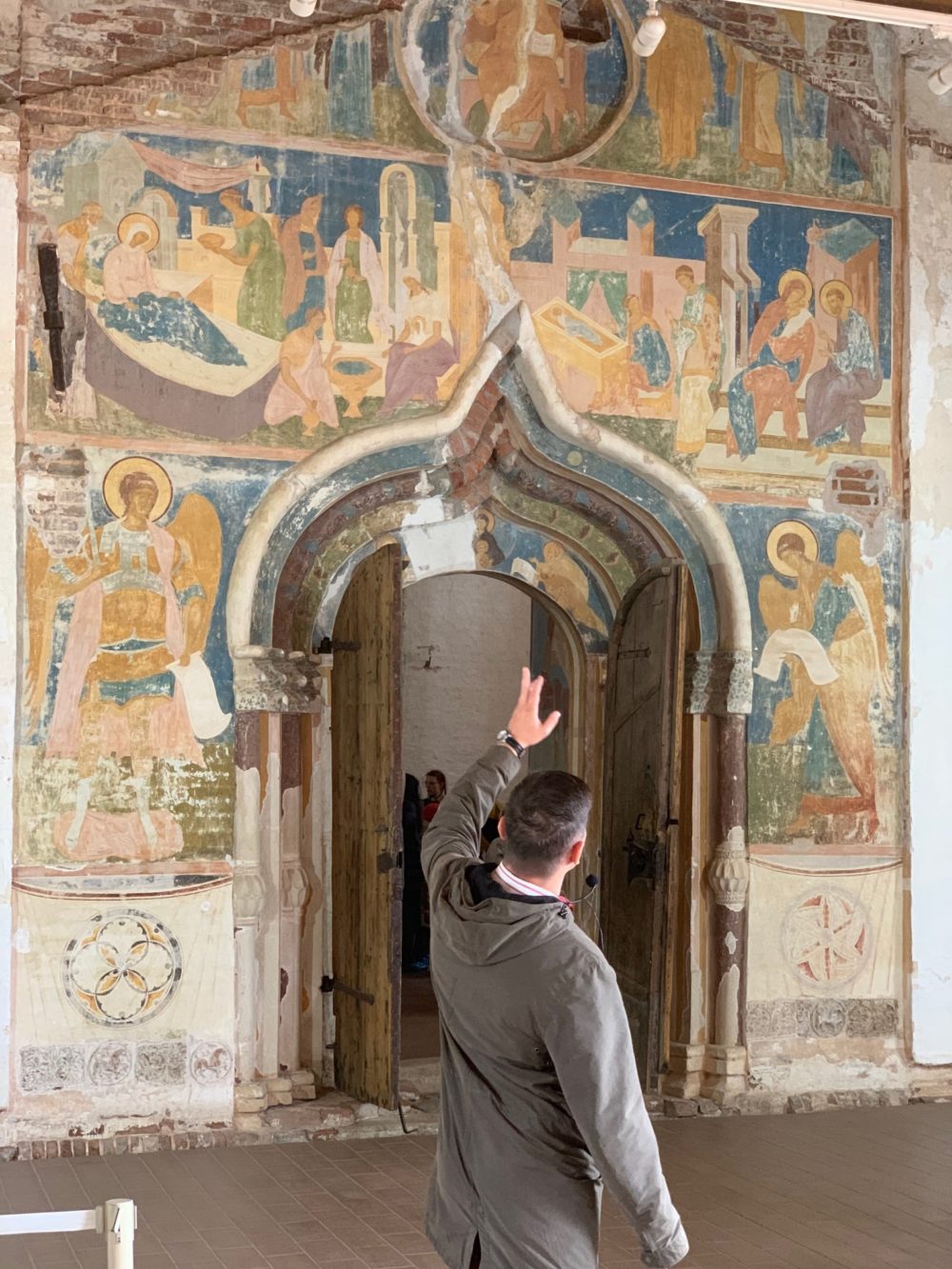
Once inside, I might have overdid it in the number of photos I took. See them below.
Each of the columns had a figure painted on each side.And yes, I also took a video while inside. They were obviously ready for me to go!
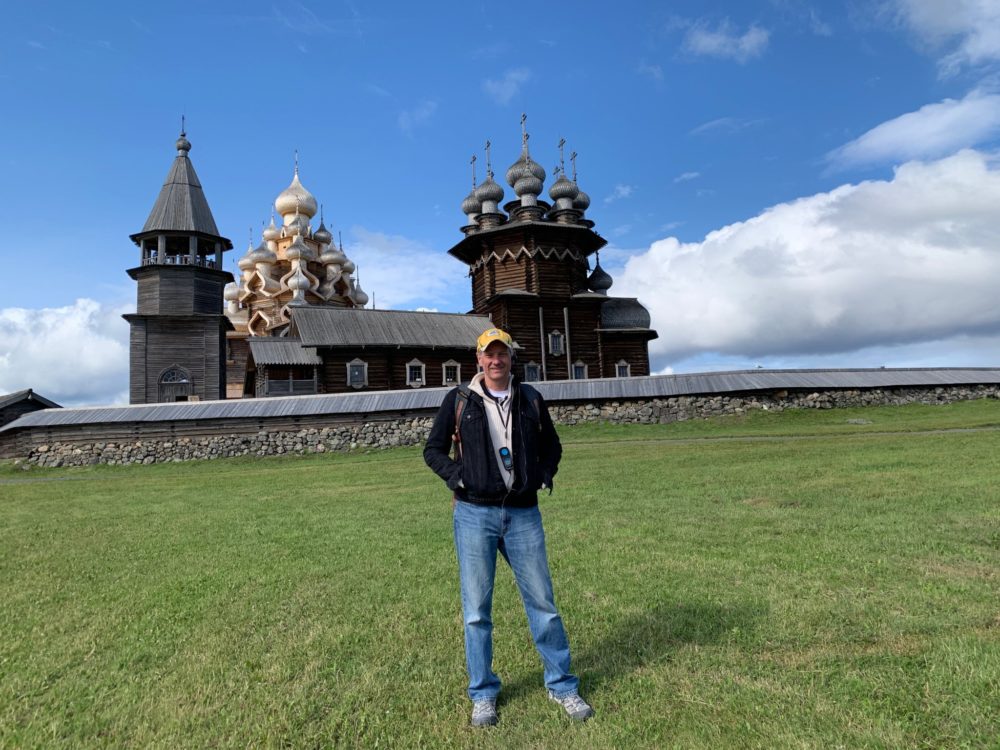
Near to the Pogost was a farmhouse set as it was years ago.
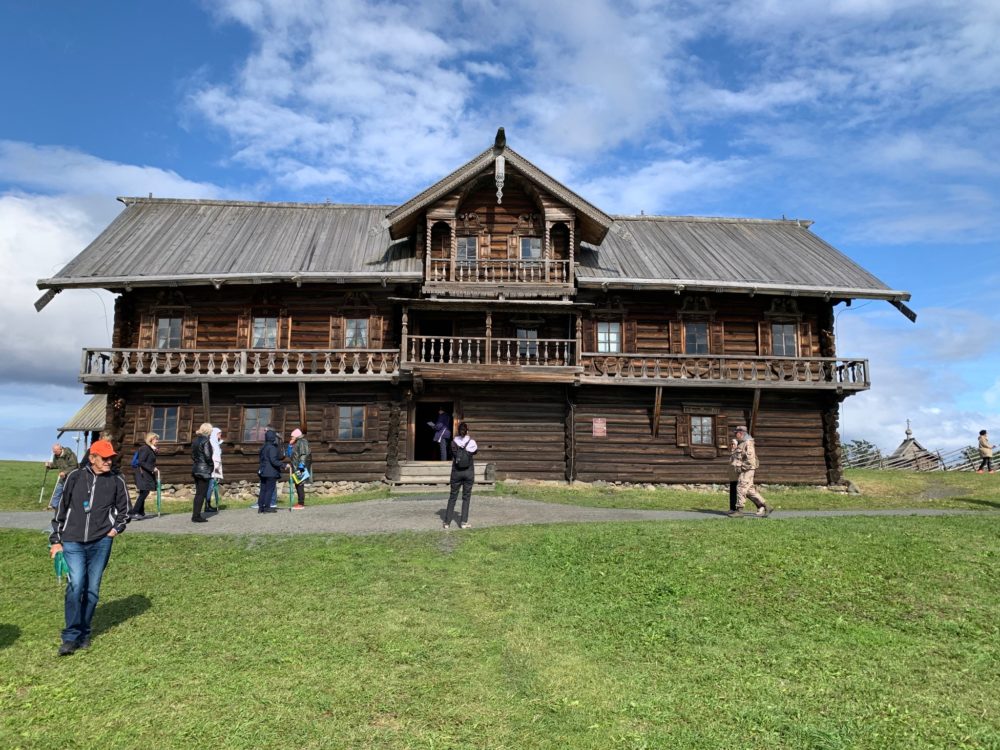
The island was and still is a gathering place for the surrounding population. The islands including Kizhi, part of the shore and the peninsula are known as Zaonezhiye. This is in the Republic of Karelia. Some research says that the island’s name came from the Karelian word “ki-zhat’ which means “festive gatherings.” I would cite the guidebook. (purchased on the island) I pulled the following historical information from, but it has no author or publication information inside. Its title is ‘Kizhi – History, Architecture, Nature”.
«In the XII century Zaonezhiye became a part of the Novgorodian feudal republic, and later (1478) it became inferior to the Moscow state. However, the economical and cultural influence of Novgorod remained for a long time.
The Kizhi island remained the center of the community villages. People lived in the settlements separated by the lake, forests and bogs. However, they needed to trade, exchange news, judge guilty people and take decisions on important issues. According to old tradition, the Kizhi island became the place of meeting again. And as all important events in Russian orthodox farmers took place either in a church or near it, the first Kizhi churches appeared on the island. They were mentioned for the first time in the second half of the XVI century.
The place behind the churches, where people used to bury the dead, and later the square in front of the church was called “pogost”. As time passed, pogost started to mean an administrative and territorial unit and was spread to the communities from which farmers came to churches. The Kizhi pogost was one of the major ones in Northern Russian and included 130 villages as early as in the XVI century.»
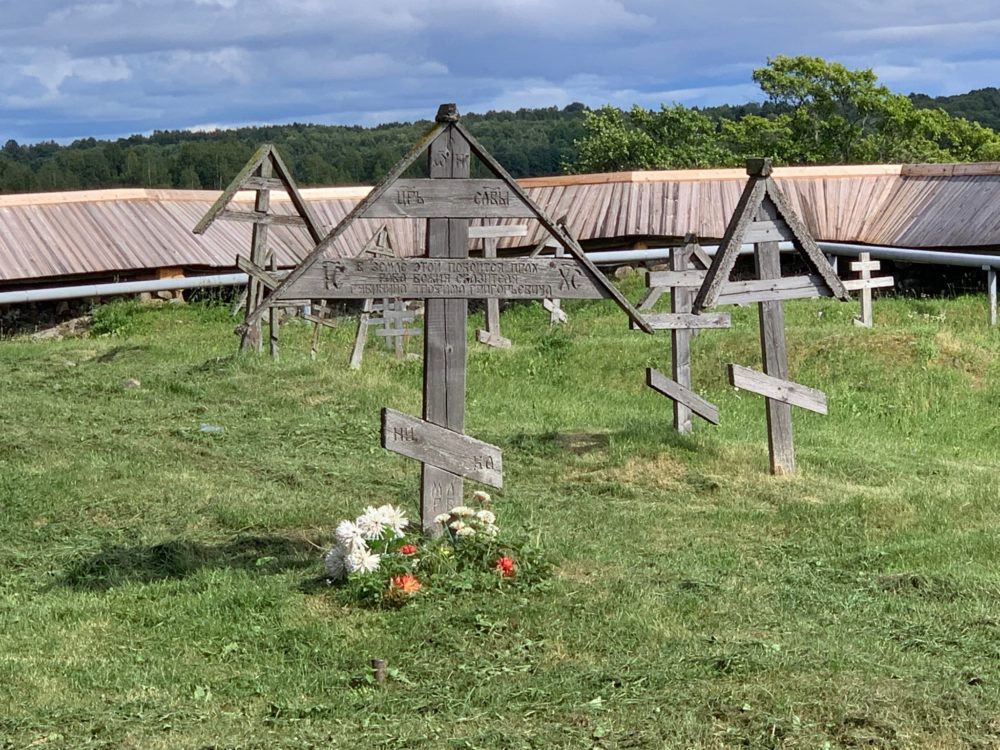
I’m not sure what the attraction was, but I took a lot of photos of a dugout that was moored close to this farmhouse. By that time the threat of rain had gone away (mostly).
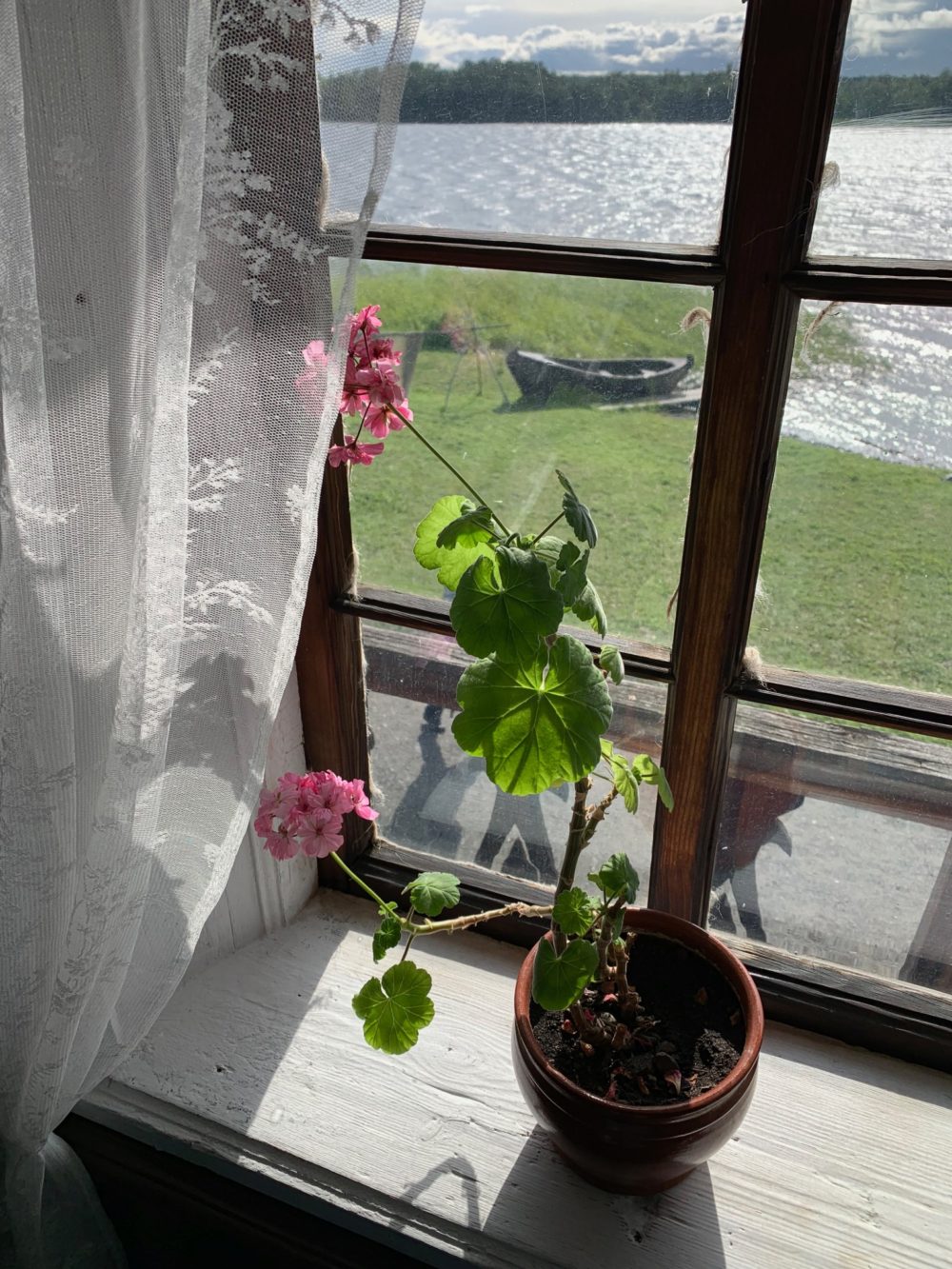
The other building near somewhat near the Pogost was the Church of the Resurrection of Lazarus. This building dates back to the 14th century, and was moved to the island from the Murom Monastery on the lake’s eastern shore. It is the oldest wooden church still standing in Russia (according to my guide book!).
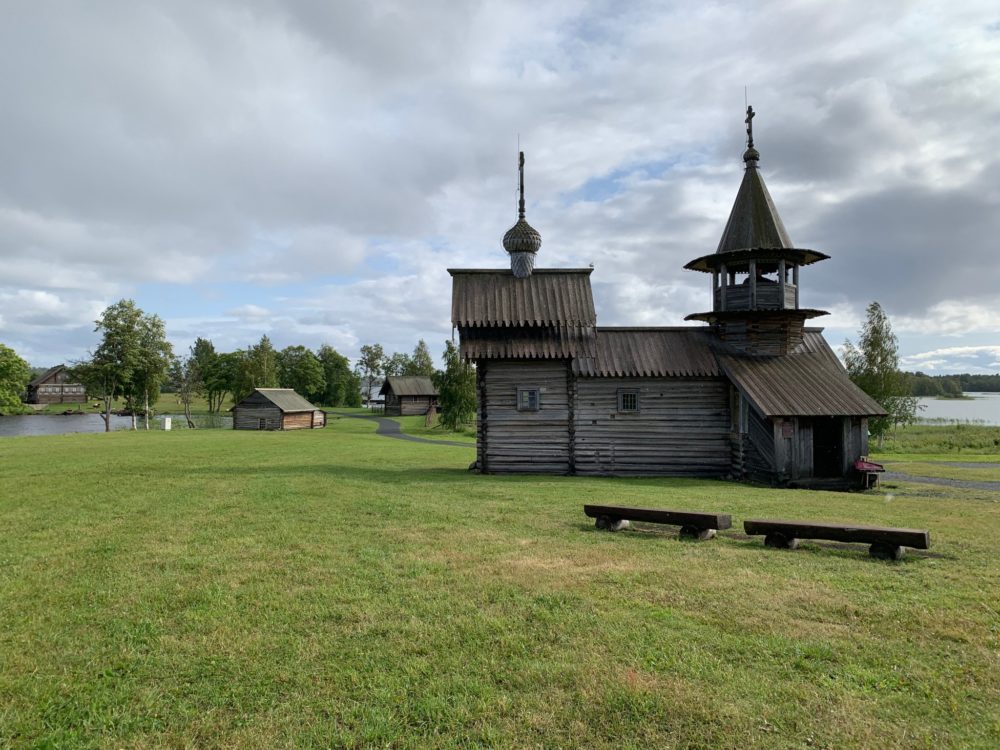
The entire island had a relaxed feel to it, like it was a very ancient farming community.
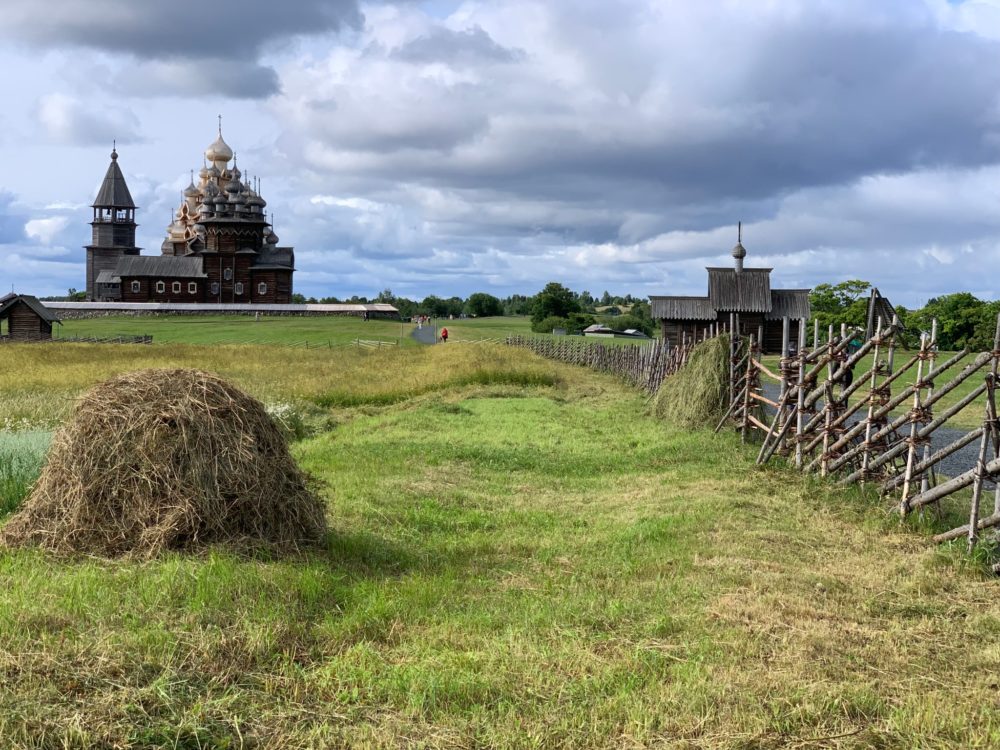
We boarded the ship, and headed for our last Volga River cruise stop before St. Petersburg. That called for one more sunset photo, this time off Lake Onega.
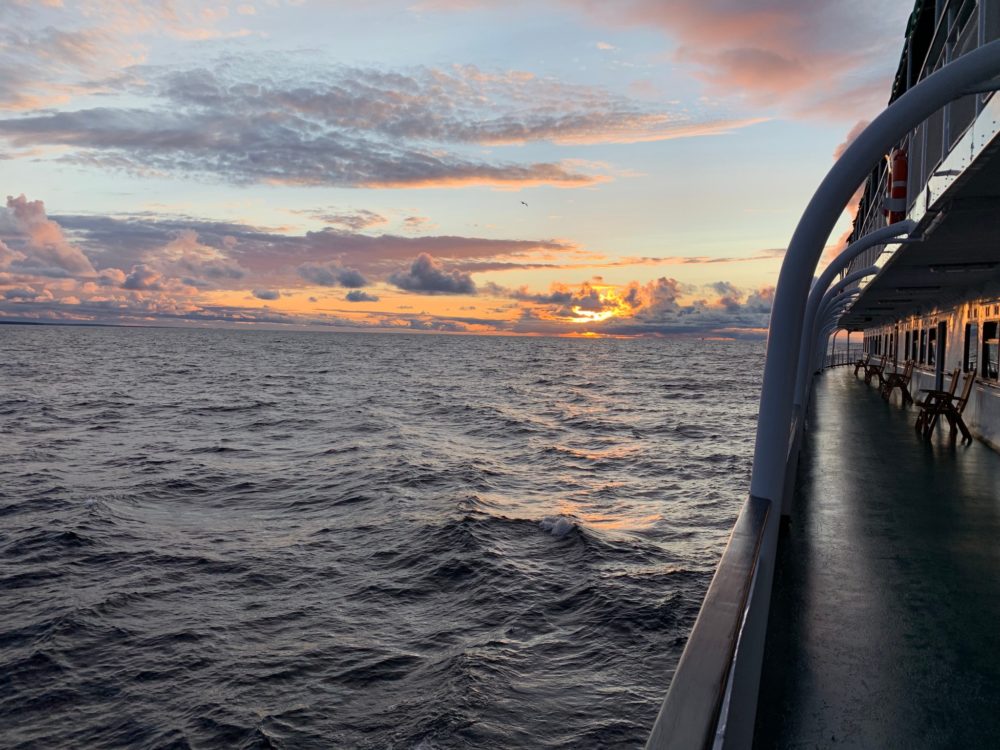
Svirstroy – last stop before St. Petersburg
The cruise made one final stop before St. Petersburg. I’m pretty sure it was a choice of either find a place to stop since it was halfway between Kizhi Island and St. Petersburg or keep on cruising. The description handed out by the cruise said the name meant “Construction on the Svir”, as their was a hydroelectric plant nearby. This was a cultural immersion stop, and at times it felt like a bit of over-the-top propaganda. We visited a retired lady’s house, and we visited a school where the students and teachers danced and played music.
The lady was gracious, had snacks laid out for us and invited us to ask her any questions. She shared the house with a couple of other retirees and had relocated there from St. Petersburg. Some of the same questions that were asked of our guides during the entire trip were re-asked: what did she think of Putin? how much did it cost for certain things like rent? how much freedom did she have?
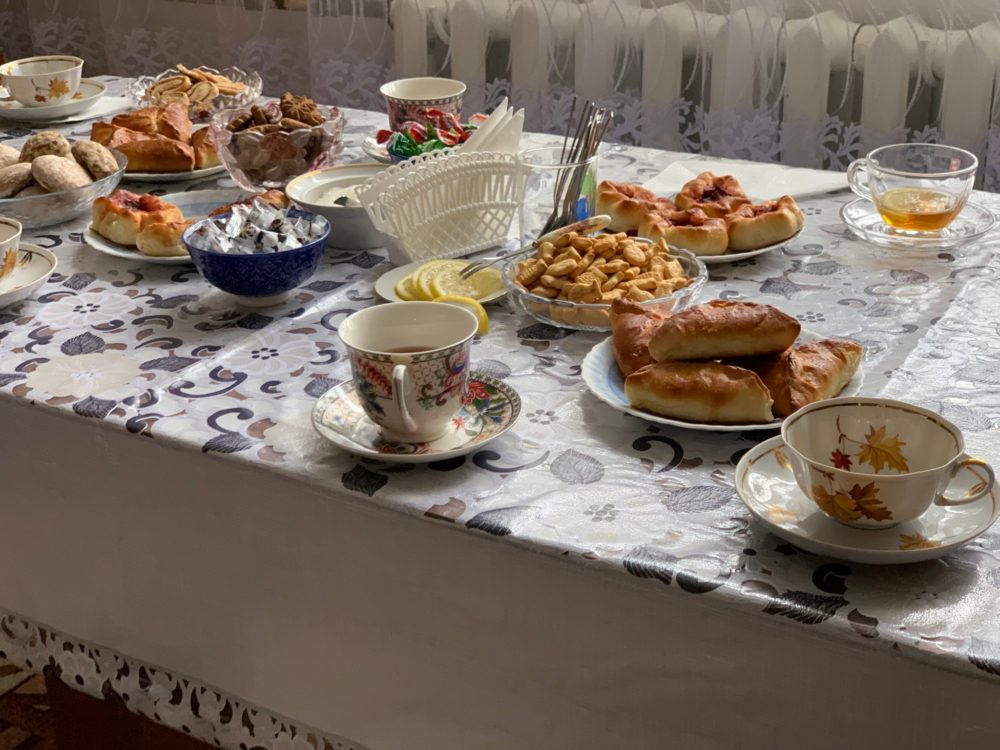
From our perspective, our observations were our best barometer so we did not have any questions for her. Even when we ventured out of the controlled confines of the tour groups, we found the Russian people to be similar to everyone else. Some disliked the current government, some did not. Most were friendly, some were not. For the most part, we found the country extraordinarily beautiful and the people complex and enjoyable. Even when my wife and I ventured off the beaten path. we found people who were trying to enjoy life just as we were.
The music and dancing were held in the small auditorium of the school. There was one teacher and student combo that was quite good.
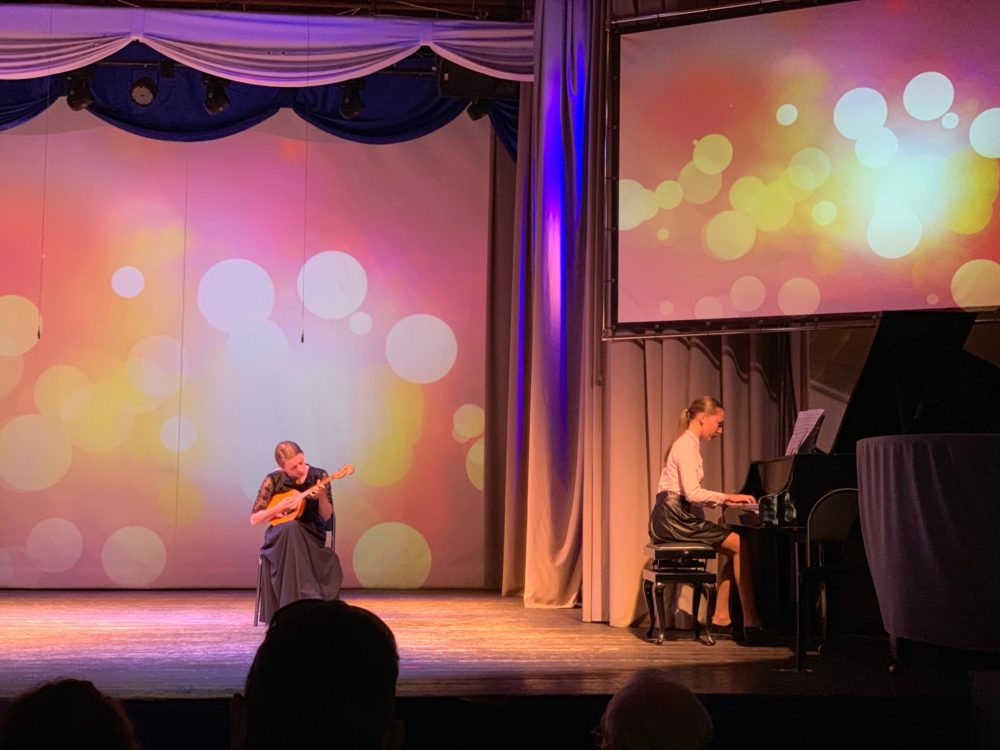
That evening, back on the boat, was the farewell dinner, and we got a picture of the entire group we had spent the cruise with aboard the Volga Dream.
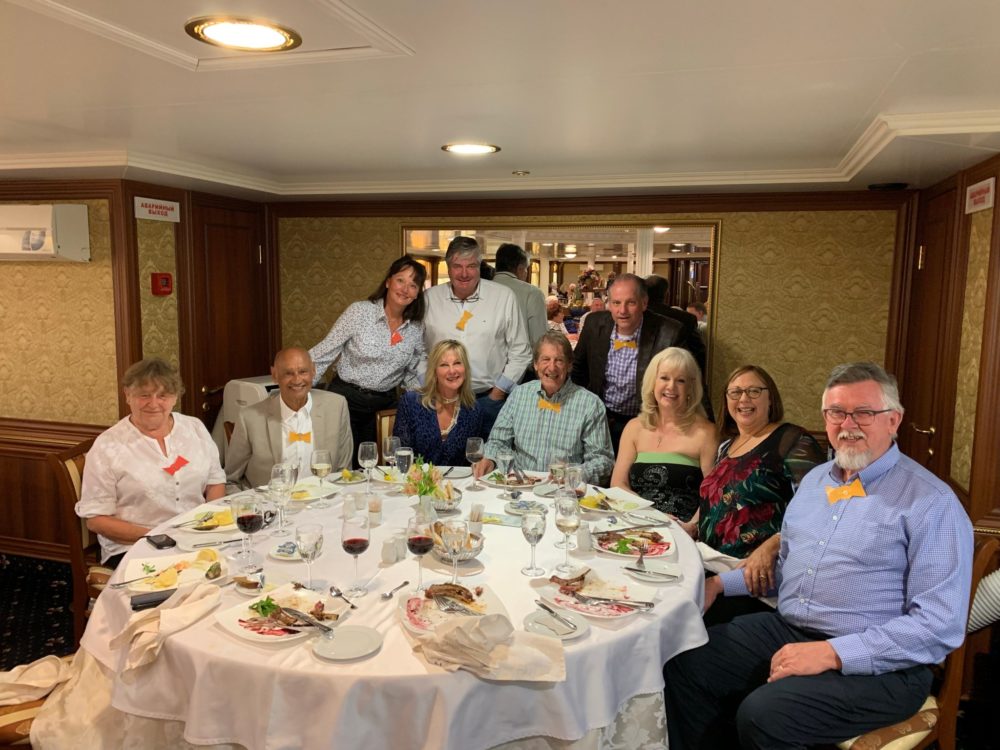
Our Volga River cruise ends in St. Petersburg
At last, on July 13, we cruised up the Neva River and into St. Petersburg. The weather continued to cooperate very nicely. After seeing very little civilization along the cruise route, waking up to this was a stark contrast.
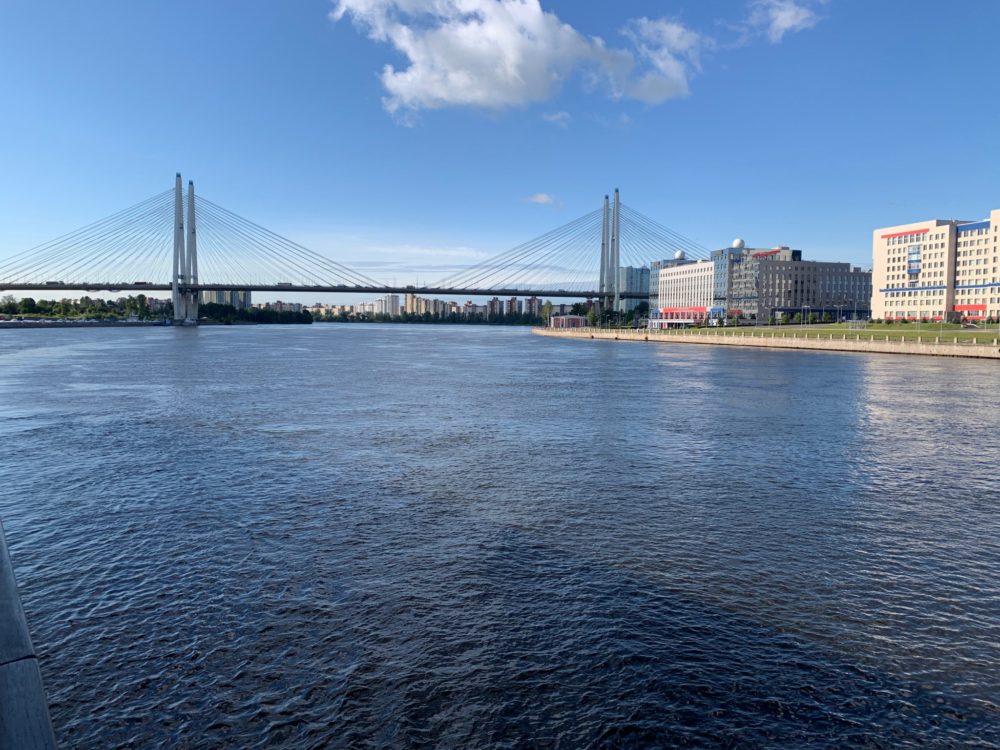
There was an obvious difference along the banks. The buildings were much more modern looking, and quite a bit more colorful.
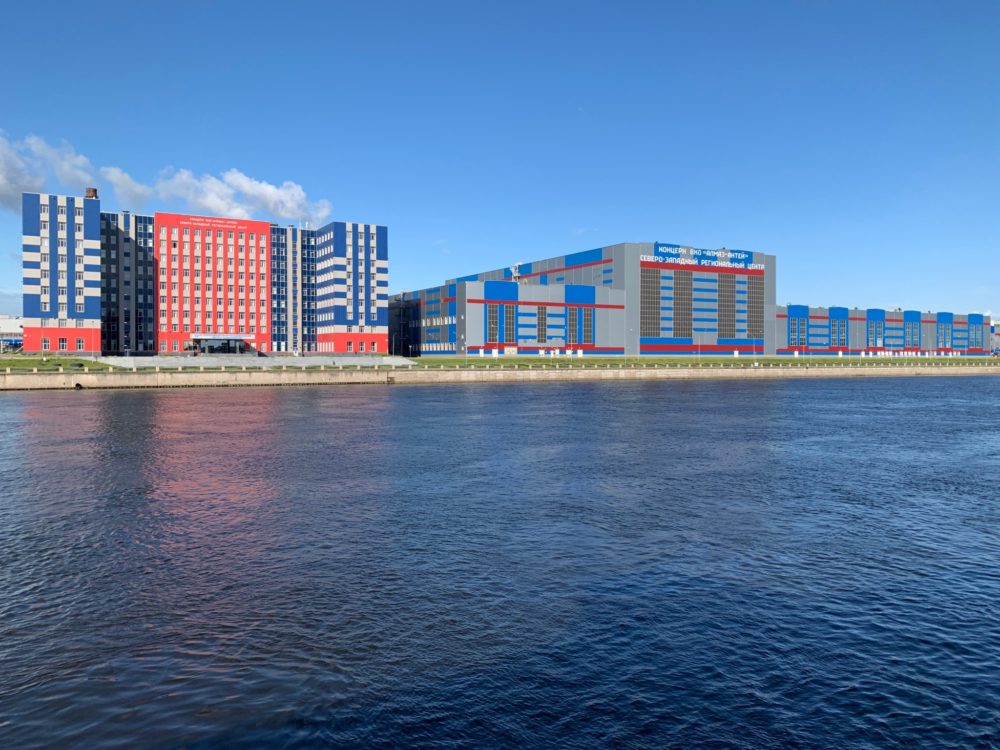
Our Volga River cruise complete, we said our goodbyes, boarded a bus and started exploring St. Petersburg.
Original source of the article and images:
https://www.duskbeforethedawn.net/2019/11/volga-river-cruise-moscow-to-st-petersburg
Larry & Audrey Ketchersid
2019

